John 5:24
"Home is the Sailor, Home From The Sea.... And The Hunter, Home From The Hill"

 Permission Granted To Come Aboard...
Permission Granted To Come Aboard...
..And Welcome To The Pirate's Lair!
a Division of DataCity, Inc.
Click Here and Return to The Pirate's Lair Home Page www.thepirateslair.com
OR
Click Here and Return to the British Royal Navy Dinnerware Main Page

Both Rare and Common Patterns and Identification Found on British Royal Navy Plates and Bowls From Early 19th and Very Early 20th Century (pre-1907 Private Mess and post-1907 general mess changeover) British Royal Navy Mess Plates and Bowls Including the "Young Head" Pattern of Queen Victoria (1837-1901) and King Edward VII (1901-1910).


Pre-1907 (ca 1830s-1850s) Private Messing Dinnerware using the Royal Crown, Naval Badge or Admiralty Crown, Roses, Thistle and Clover, British Flags, Crown and Anchor as Centerpiece Designs and Hand Glazed Mess Numbers. Post-1907 General Messing of enlisted sailors using plain and simple fouled anchor badges as there was then no longer any need to have mess numbers.
While most of the British Royal Navy Mess Plate patterns and designs used a standard transfer decal method of putting the design onto the plate it still took a fair amount of hand craftsmanship to do this. Additionally each Mess No was individually hand painted or drawn onto the plate in a blue matching glaze after the decal was put on.
The use of intertwined roses, thistles and clover on much of the early mess plates and bowls were to represent the relationship of England, Scotland, and Ireland! Of note is the missing dafodil representing Wales, which has not ever been found on any Royal Navy dinnerware - strange to say the least.
Call The Pirate's Lair @ 540-659-6209
Pattern #1 - 1850s-1870s Pre-1907 Fletcher-Miller Ship-Flag-Anchor Center Pattern

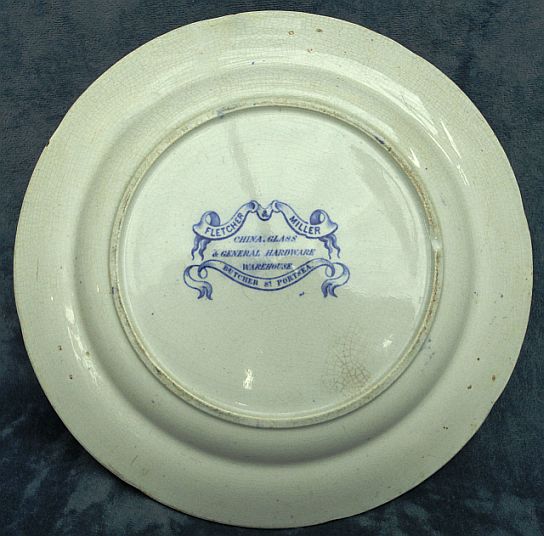
An exceptionally beautiful and well detailed Royal Navy Mess Plate No 16 early/mid-19th Century Victorian Era most likely made by the Bovey Tracey Pottery Company for Fletcher Miller which supplied and warehoused all sorts of items for the Royal Navy in Portsmouth. Images used blue transfer decals or also known as "flow blue" china. This sold at auction for over $1000.USD


We have in our collection this pattern of mess plate with No's 6 and 20 which means that this pattern was used across a number of onboard established messes and was not just an orphan design. This particular pattern is so detailed, beautiful and rare it must have been manufactured for and used on a specific flagship or ships-of-the-line of a certain British fleet.
Of significant note is that this is one of the very few Royal Navy Mess Plates that did not have either a Royal Crown or Admiralty Crown as part of its centerpiece. We do not know the significance of this, if any. However it does incorporate intertwined roses, thistles, and clover representing England, Scotland, and Ireland entwined throughout and around the naval motifs.
It is unclear as to whether this pattern had corresponding and matching bowls as did some of the patterns.
Rear and Backstamp of Fletcher-Miller Mess Plate No 16 which reads:
Fletcher & Miller, China, Glass & General Hardware Warehouse, Butcher St. Portsea
Which was a well known commercial company servicing the Royal Navy in and around Portsmouth in the 19th century.
While a specific production date in the 19th century can be identified, the depiction of a sailing ship having a side paddle wheel certainly indicates that this mess plate was produced after the introduction of steam powered propulsion systems aboard naval sailing vessels.
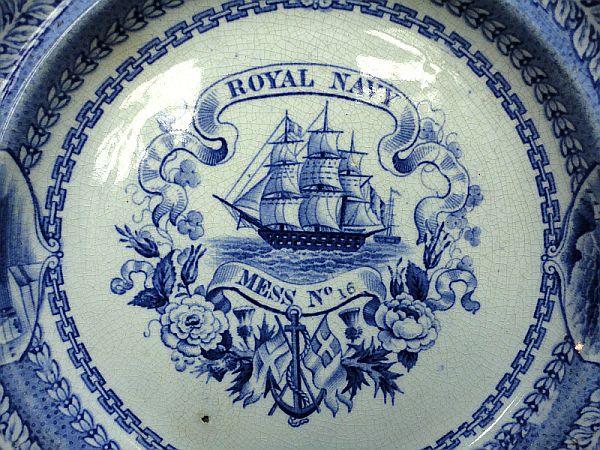
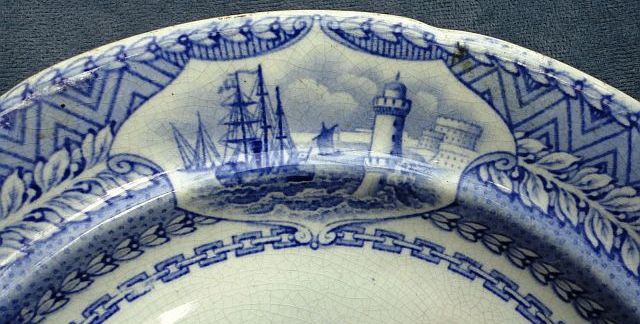
More detailed photos of Fletcher-Miller Mess Plate No 16.
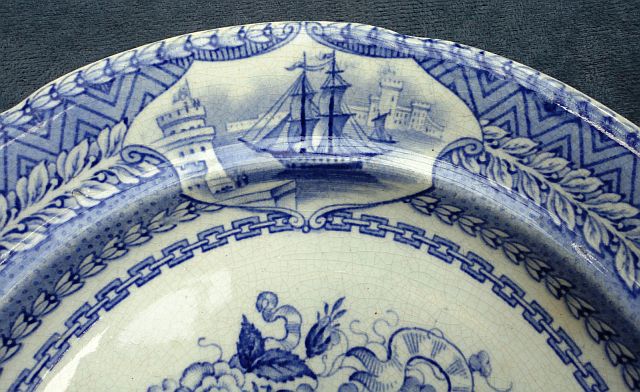
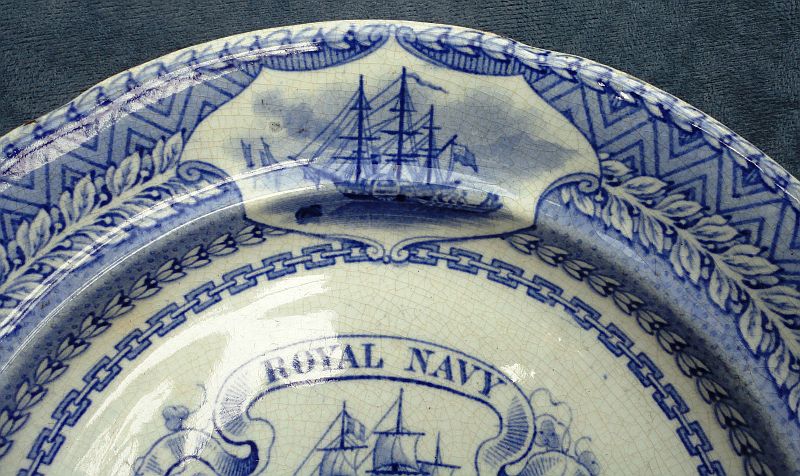
More detailed photos of Fletcher-Miller Mess Plate No 16.
Pattern #2 - 1850s-1870s Pre-1907 Roses, Thistle, Clover, Flags and Anchor Centerpiece Pattern
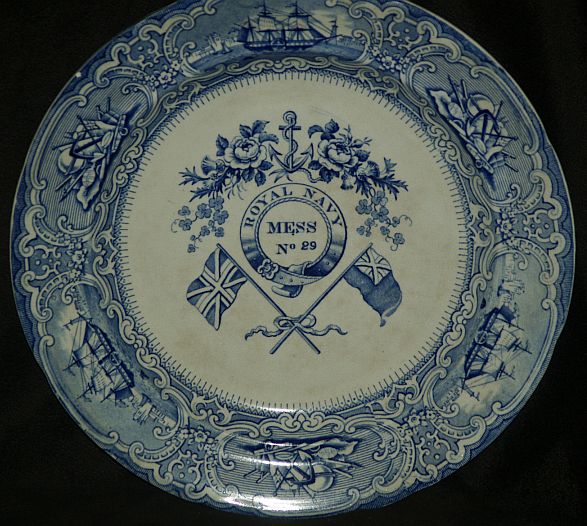
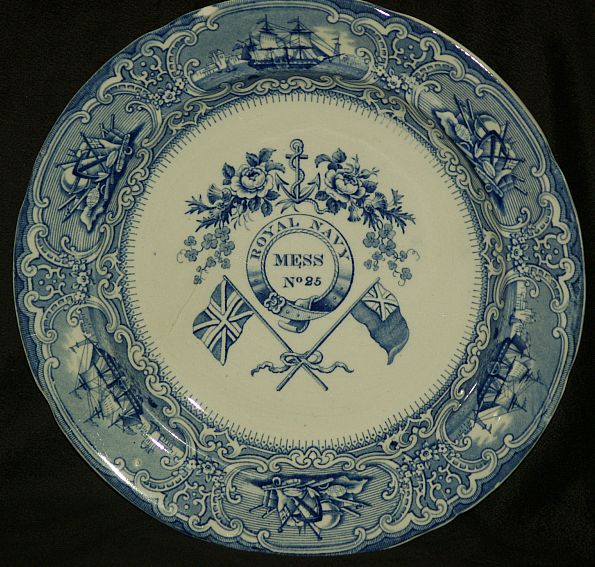
Above is another beautifully detailed early/mid 19th century pair of Naval Mess Plates with naval scenes of ships and a compilation or montage of flags, anchors and other nautical items of an unknown identification.
Note again the use of entwined roses, thistles, and clover representing the British Iles of England, Scotland, and Ireland! The transfer decal along the edge consists of a wooden sailing ship man-of-war in a harbor setting and a compilation of flags, anchors and other unknown nautical items. These two scenes are repeated three times around the rim of the plate.
There were no manufacturers backstamps or arsenal marks on the rear of either of these plates to help establish provenance. However as in the first pattern shown on this page the sailing ship has a side paddle wheel which certainly indicates that this mess plate was produced after the introduction of steam powered propulsion systems.
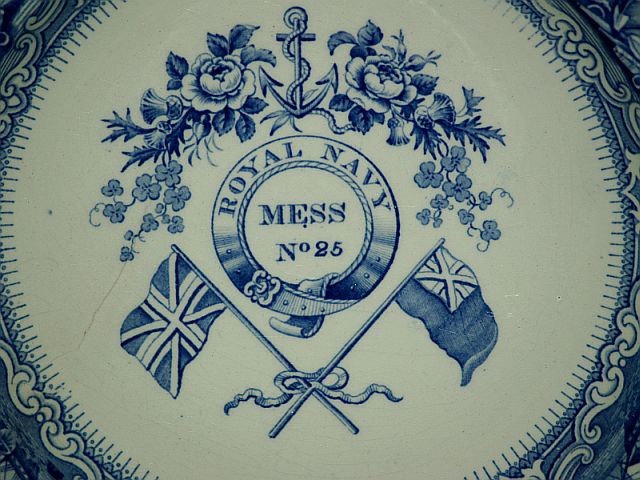
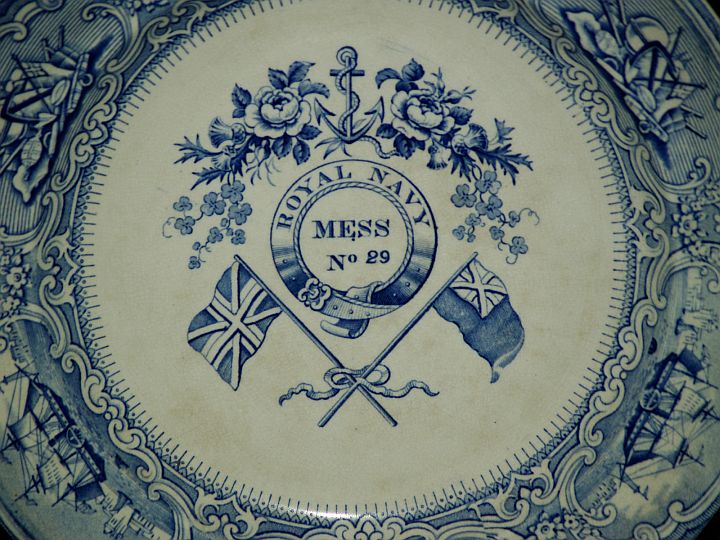
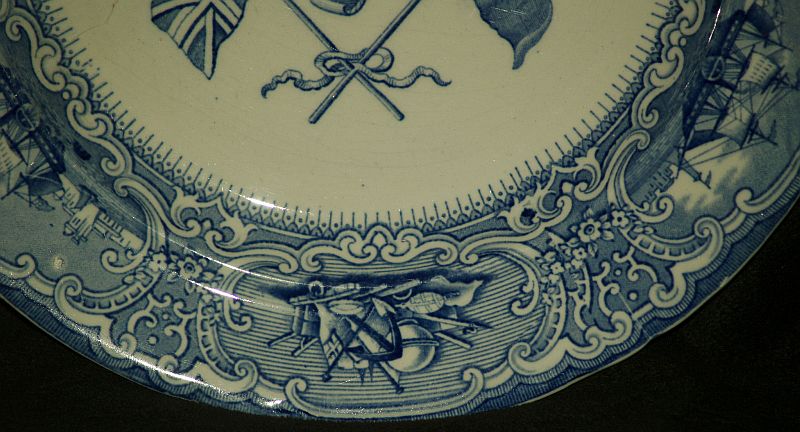
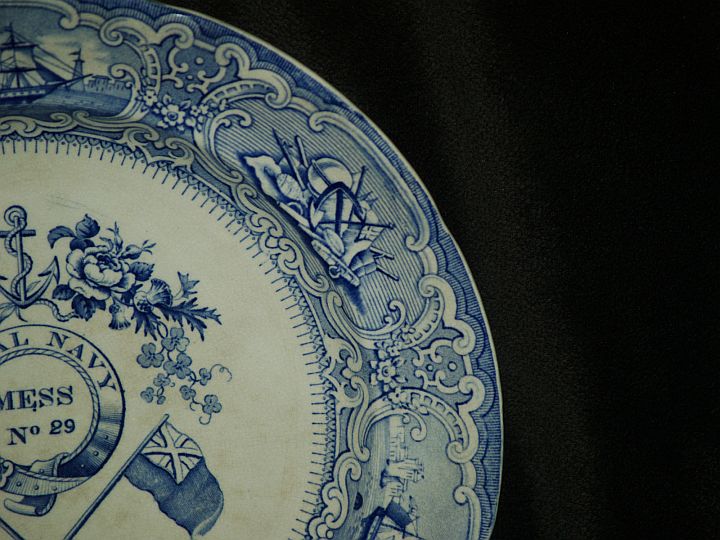
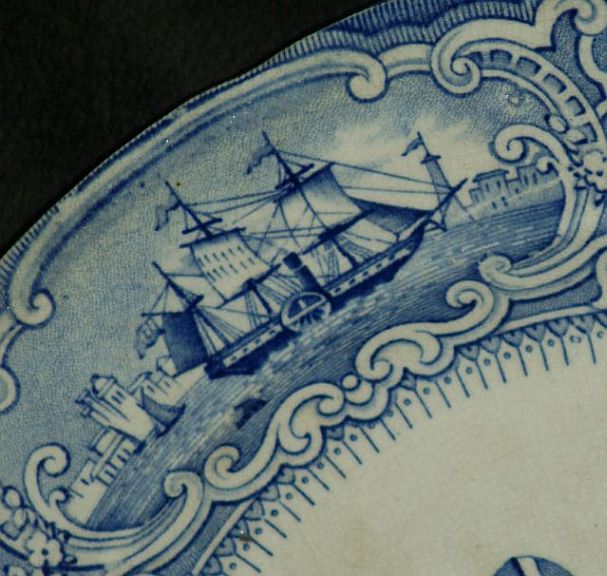
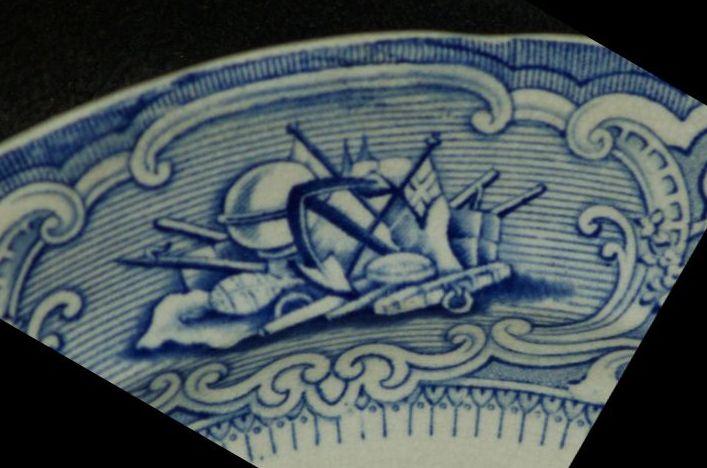
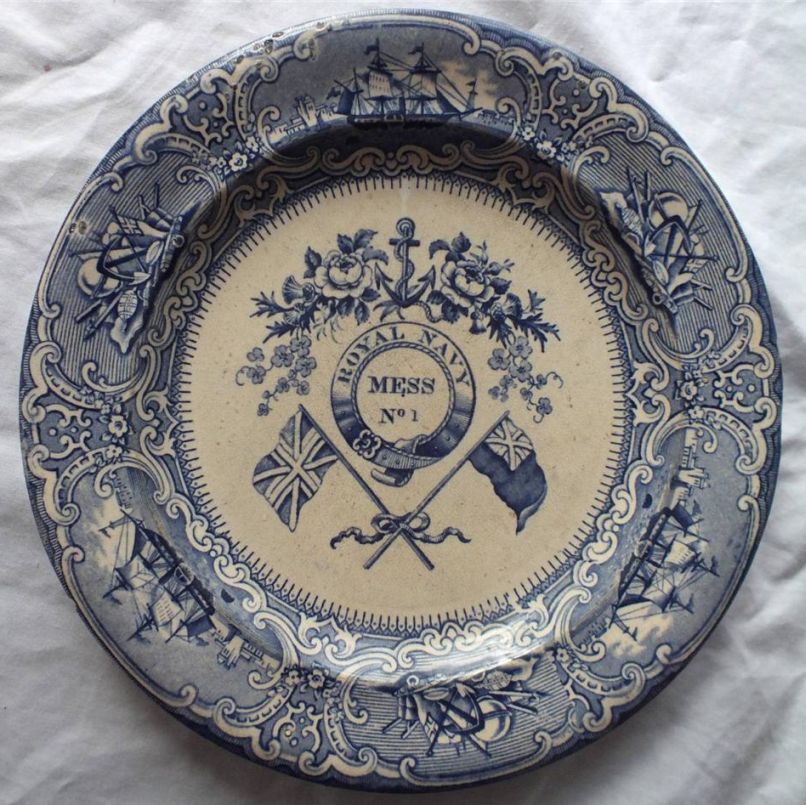
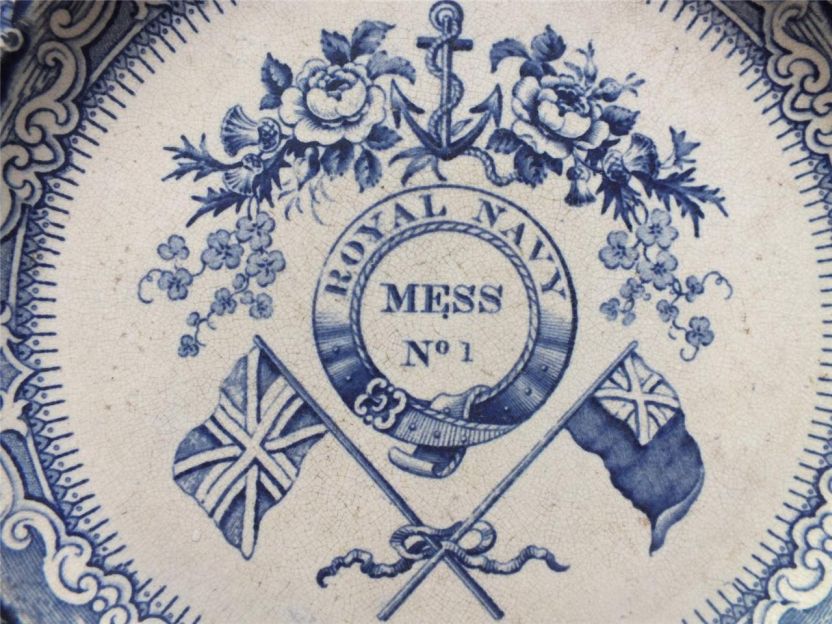
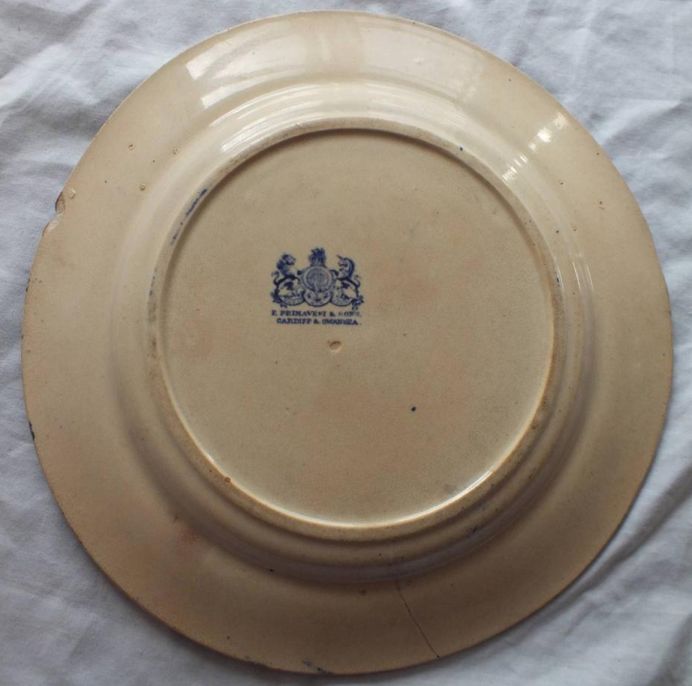
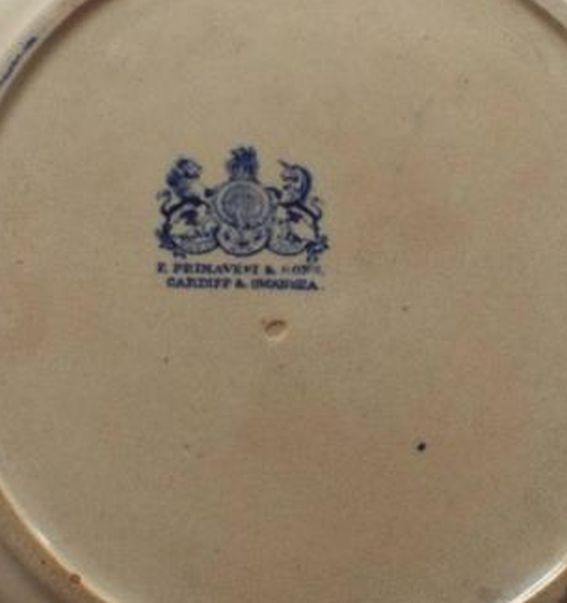
Above is same pattern for Mess No 1 along with the manufacturers backstamp which helps determine age of the piece.
Pattern #3 - 1880s-1906 Pre-1907 "Young Head" Pattern with Royal Crown as Centerpiece Pattern

Above two plates illustrate the standard British Navy Mess Plate of the mid/late 19th Century and very early 20th century with what is known in the trade as the "Young Head" and Crown Pattern - one to the left with Queen Victoria (1837-1901) and the one to the right with King Edward VII (1901-1910). This pattern was known as the "Young Head" due to the young looking busts of Queen Victoria and her son King Edward.
This particular "Young Head" design used various centerpiece designs and configurations - the one shown is the "Crown" for obvious reasons. It is our conjecture that this particular Young Head pattern was the most standardized and mass produced of all pre-1907 British Royal Navy Mess Plates and Bowls due to the sheer amount found available and the relative average to poor quality craftsmanship when the blue transfer decal was applied.
Much but not all of the "Young Head" blue transfer decal pattern was produced for the Royal Navy was by the Bovey Tracy Co Ltd. This type of transfer decal is also known as "flow blue" in the antique china market. Spode along with most other 19th century British china and porcelain production companies had "flow blue" or transfer decal offerings.
Below are Matching Royal Navy Mess Bowls in the Young Head Pattern with Royal Crown
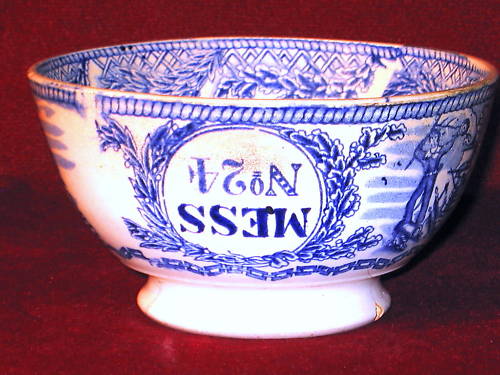

Above are two Mess No 24 bowls. Photo to the left is right side up and ready to be used with Mess No 24 showing upside down. While the photo to the right is upside down in the stacking or storage position. The Mess No's were put upside down so that when these and other bowls from the various messes were washed and stacked they could be easily identified as to what mess they belonged to.
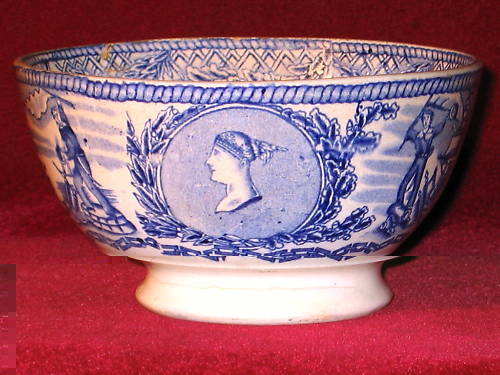
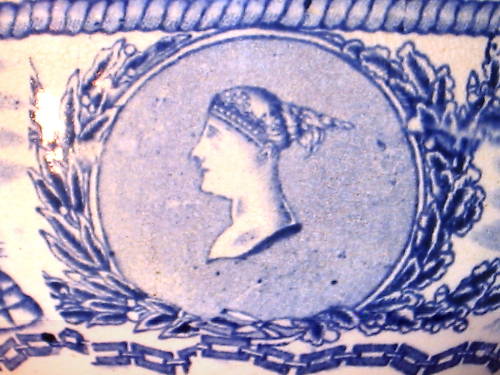
Above photos show Bowl Mess No 24 scenes. First is the bust of Queen Victoria, note the simulated rope along the rim of the bowl and the chain links at the bottom edge and the naval scenes being depicted to the left and right of the bust.
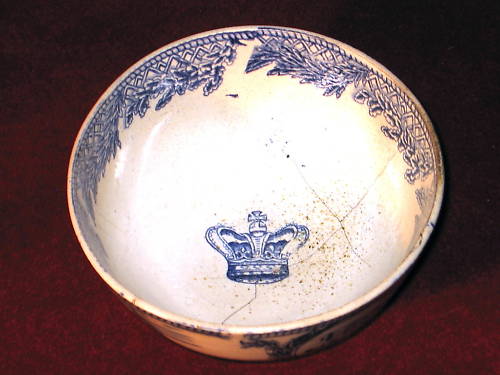
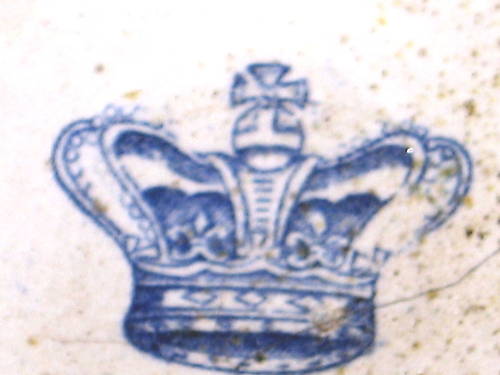
Showing the inside of the bowl. Photo to the right shows the Queen's crown which is slightly different than the Kings.

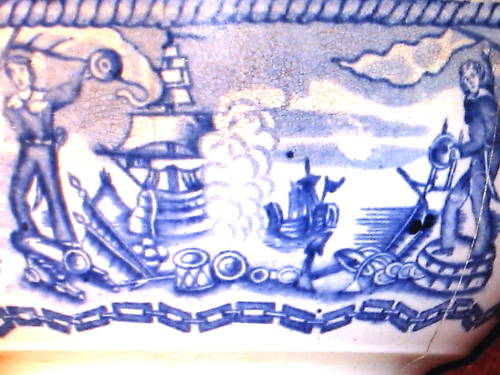
Two british royal navy jack tars celebrating with two ships in the background. Upon close inspection it appears the two sailors celebrating captured booty with the large ship to the left vanquishing the ship to the right
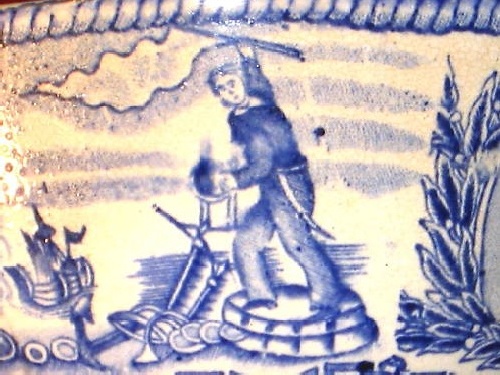
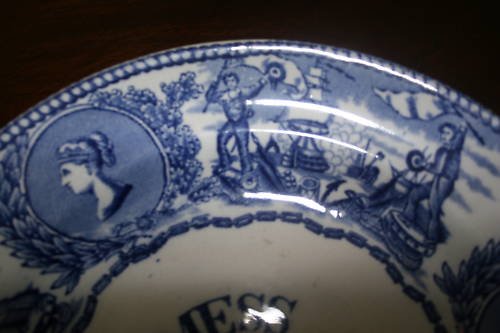
Just another closeup of the sailor to the right in the naval scene holding up a flag celebrating some sort of victory.
Pattern #4 - 1860s-1880s - Pre-1907 Young Head Pattern with Crossed Flags and Crown as Centerpiece Pattern

Mess Plate No 1 above illustrates a "Young Head" pattern with Queen Victoria with but with a different centerpiece of crossed British Flags and Naval Ensign with Crown.
Pattern #5 - 1850s-1870s Pre-1907 French Inscription, Anchor, and Crown as Centerpiece Pattern - Known as the "Morgan" Pattern
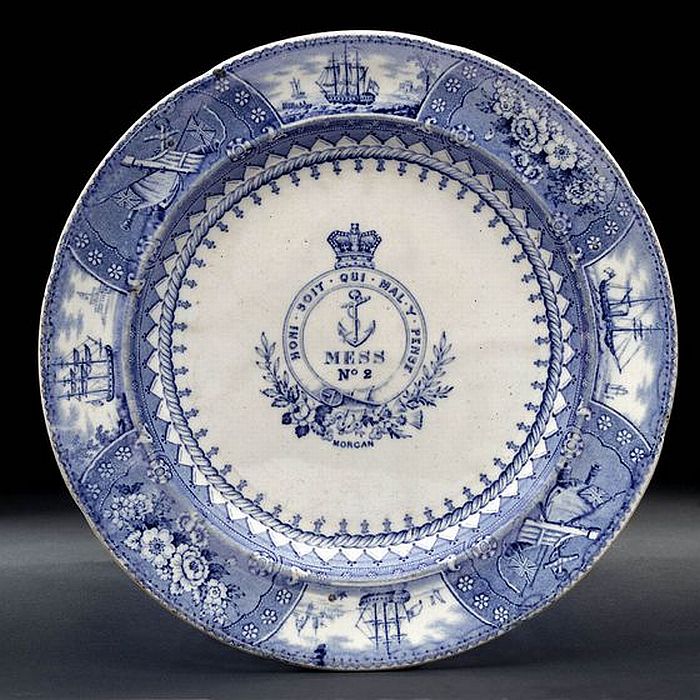
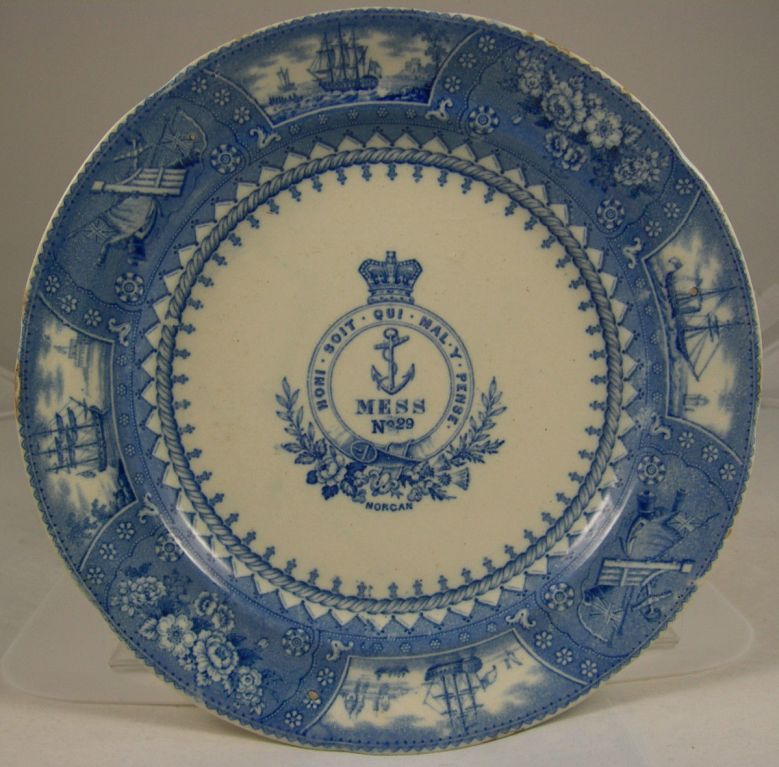
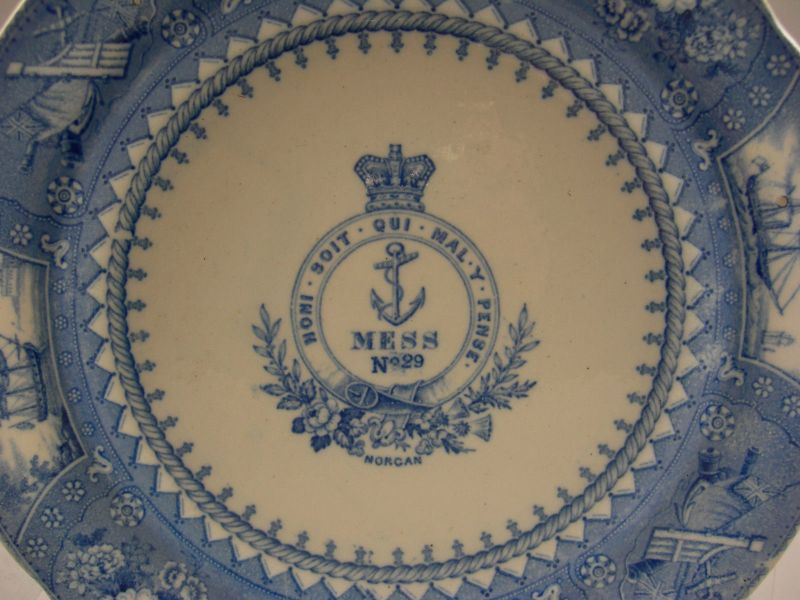
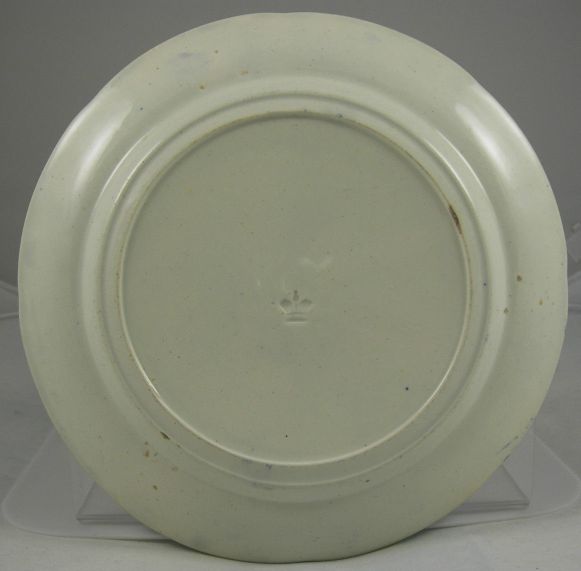
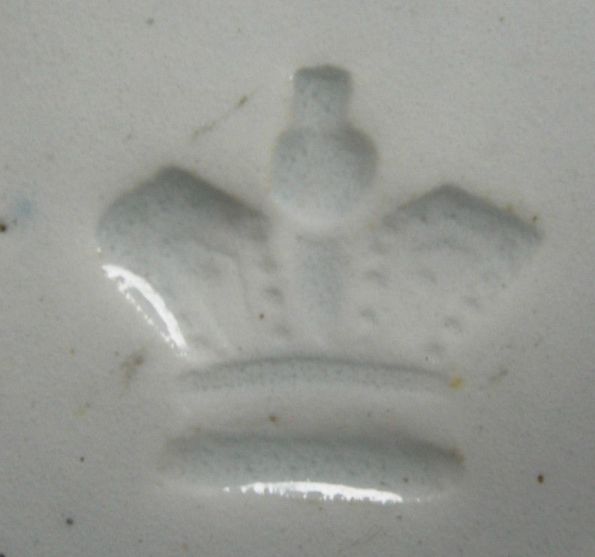
Mess Plate No 2 and No 29 above illustrates a rare non-young head pattern with various naval scenes around the rim along with flowers and foliage consisting of roses, laurel, and thistles representing England, Wales, and Ireland. The middle has a centerpiece consisting of a round fouled anchor badge surrounded by the old french inscription inscription "Honi soit qui mal y pense" translated to "Shame be to him who thinks evil of it", or more strictly: "Let he who thinks ill there be shamed",
or as it is sometimes re-interpreted "Evil be to him who evil thinks".
Pattern #6 - 1830s-1850s Pre-1907 Intricate Rope Design and Naval Badge with Royal Crown as Centerpiece Pattern
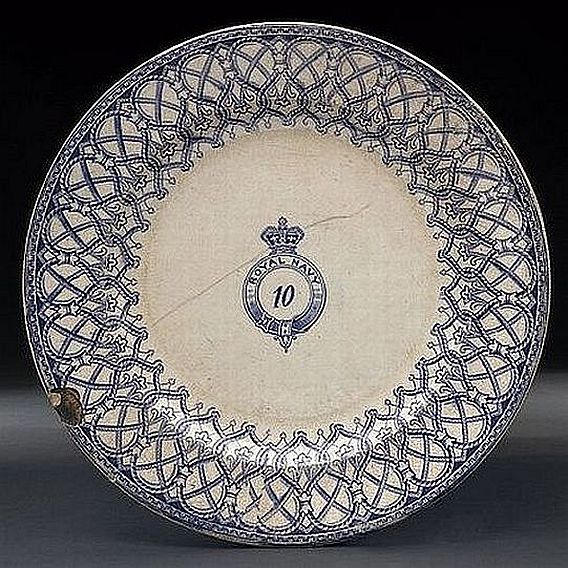
Another rare and beautiful British Royal Navy plate pattern of the 19th century. This plate uses an intricate network of rope around the edges with a relatively plain and simple naval badge with mess number 10 below a Royal Crown. The simplicity of this naval badge actually draws attention to the beautiful intricacy of the rope design.
Pattern #7 - 1880s-1906 Pre-1907 Royal Navy Barracks Portsmouth with Naval Badge and Admiralty Crown as Centerpiece Pattern

A relatively plain mess plate made specifically for the Royal Navys Barracks in Portsmouth, England. Without any other decorative pattern the centerpiece consists of a Royal Navy Badge with a Mess Number and Admiralty Crown instead of a Royal Crown. It is presumed that this particular plate was made either in the very late 1890s or very early 1900s just prior to the change from individualized messes to the general mess.
Pattern #8 - 1880s-1905 Pre-1907 Royal Navy Bowl with Plain Center Badge

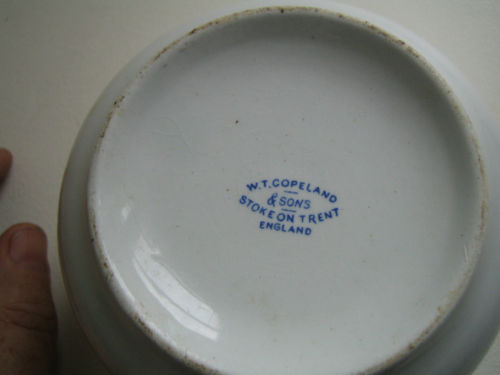
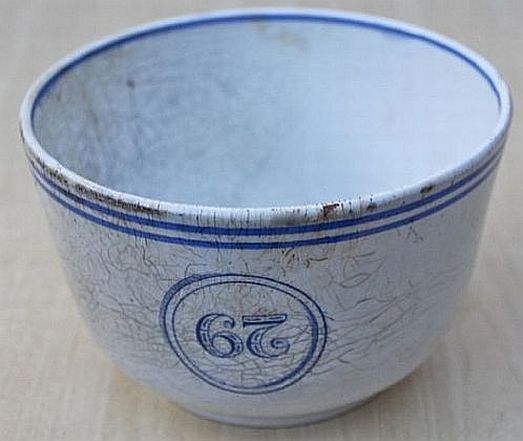

A plain yet very rare Royal Navy Mess Bowla with Mess 18 and Mess 29 encircled in blue with double blue stripes along the rim. Both were produced and bottom marked: W.T. Copeland & Sons, Stoke On Trent, England.
Both of these bowls were individually found by a freelance scuba hobbyist and a British Royal Navy diver performing an inspection of Portland Harbor after a large commercial tanker churned up large amounts of mud and sediment with its massive screws. The diver found 1000's upon 1000's of shards of broken china and in all the mud and muck found mess bowl No 18 completely intact without a mark on it, while mess bowl No 29 certainly has seen the elements!
It is assumed that in some distant past the Royal Navy discarded 1,000's of mess plates and mess bowls over the side of some ship onto the bottom of Devon, Portsmouth, Portland Harbor which was used by the British Navy from 1849 to 1996 when it was sold. It was used most extensively by the British Fleet from about the 1860's thru WWII. Perhaps these bowls were discarded after the British Royal Navy went to the general mess in 1907, or perhaps they were discarded much earlier when the ship they were on obtained newer bowls with a different pattern.
Pattern #9 - Early 1900s Post-1907 Royal Navy Dinnerware with Admiralty (Naval) Badges


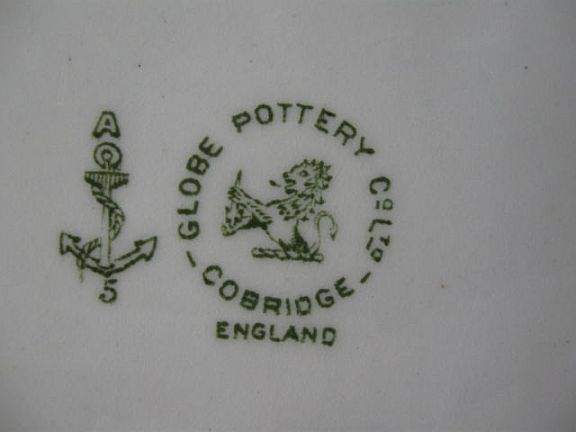
The above and to the left Royal Navy mess plate is post-1907 and estimated to be ca 1923 based upon the Admiralty Badge being used without a Mess No and the manufacturers backstamp.
This certainly is one of the very first post-1907 patterns used after the Royal Navy went to a general mess.
This particular plate was produced by Globe Pottery & Co. Ltd. of Cobridge, England, and backstamped with a Royal Navy Government Inspection and Approval Stamp consisting of a capital A above a Fouled Anchor with the inspection number 5 below.
The simple "Admiralty Badge" consisting of a crown with the rear of a wooden warship in the middle flanked by sails each in turn flanked by laurel was first established by the British Royal Navy in the 1600's as an official naval insignia. Sometimes one will see the two laurels replaced by the port and starboard sides of a wooden ship.
It was originally found in Tasmania, Australia and the person who found it said that it was discovered while scuba diving in some bay which used to be home to the Royal Navy from the 18th century to right after WWII.
Pattern #10 - Early 1900s Post-1907 Ca WWI Royal Navy Dinnerware with the Admiralty or Naval Badge

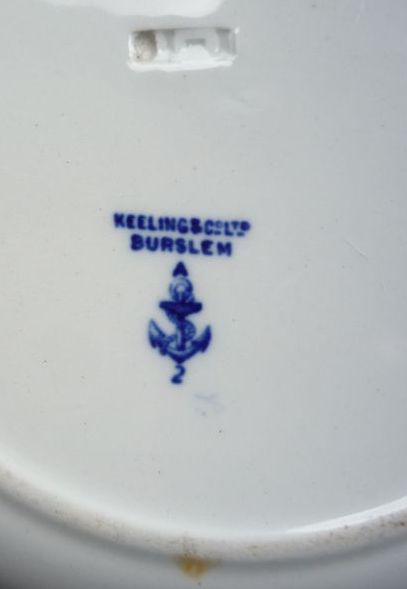
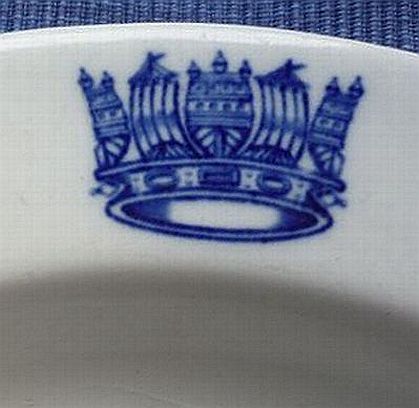
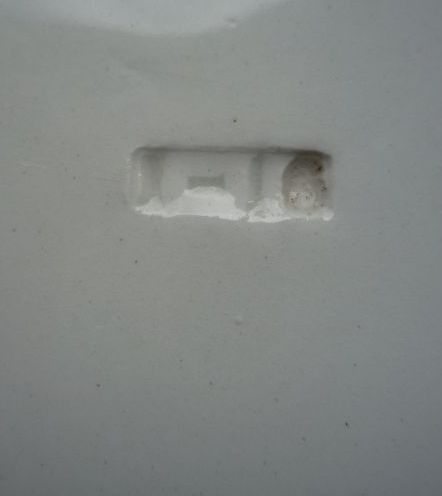
Above Royal Navy Mess plate represents another similar post-1907 "Admiralty Plate" with a blue insignia (dated 1916) consisting of a 19th century naval badge very similar to the first plate shown with a green naval badge.
However the insignia on this plate more closely matches with the original "Naval Badge" as established in the 17th century by the British Admiralty in that the far left and right portions of the crown very clearly show the starboard and port sides of a wooden man-o-war!
This plate was produced by Keelings & Co. Ltd. of Burselem, England and has a similar Royal Navy Government Inspection and Approval Stamp consisting of a capital A above a Fouled Anchor with the inspection number 2 below.
However the back of this plate also has an impressed mark of "1-16" which we believe to be the manufacturing date of January, 1916!
Pattern #11 - Early 1900s Post-1907 WWI era Royal Navy Bowl with Fouled Anchor

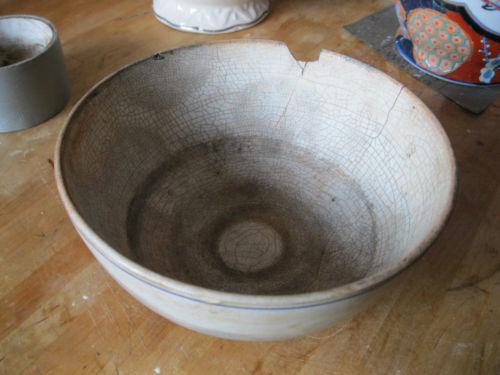
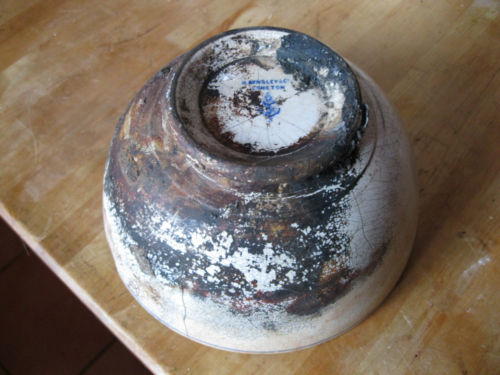
Above is relatively plain post-1907 ca 1907-1915 British Navy Mess Bowl produced by Aynsley China Co and used in the General or Centralized Mess aboard ship post 1907 (the "berthing" mess period was pre-1907) for British sailors or ratings as it only has the British Royal Navy's Fouled Anchor as an insignia vs. a designated Mess No. This particular pattern of white porcelain china with a simple blue fouled anchor was discontinued in 1926.
Additionally, the story of this Mess Bowl is that it was found washed up on a beach from the wreck of the HMS Arethusa. During the beginning days of WWI the HMS Arethusa, which fought in many sea battles with the German Navy, in February 1916 hit a mine just off Felixstowe, England and she ran aground on Cutler Shoal where she was abandoned and allowed to break up.
Apparently in the late 1960s after a large storm this bowl was found washed up on the beach from where the Arethusa had sunk and broken up 50 years previous. The Mess Bowl certainly has salt water, mud, and marine staining consistent with long-term submersion in the sea to at least substantiate part of the claim.
Pattern #12 - Pre-1907 Pattern Consisting of a Thistle, Shamrock and Tudor Rose with Anchors, Chain, Centerpiece of Split Tail Royal Navy Flats, Crown, and Buckle with the French Motto
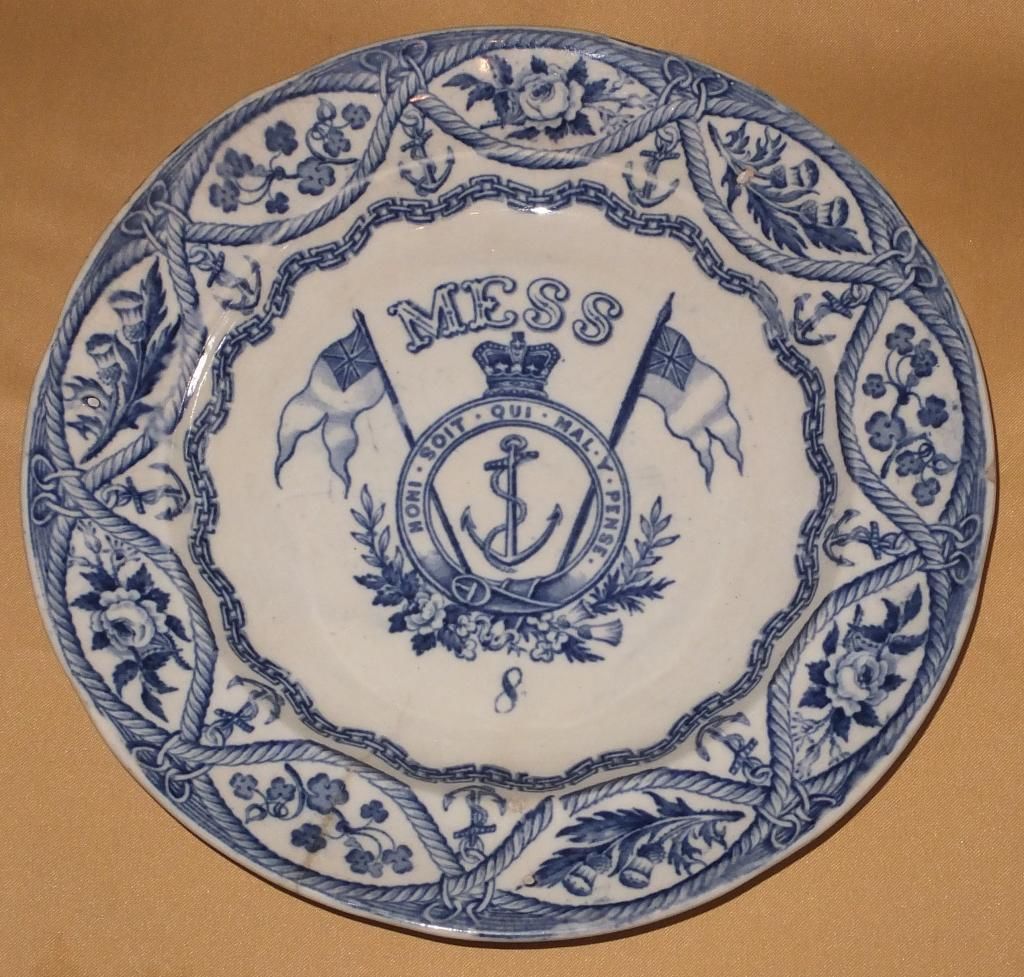
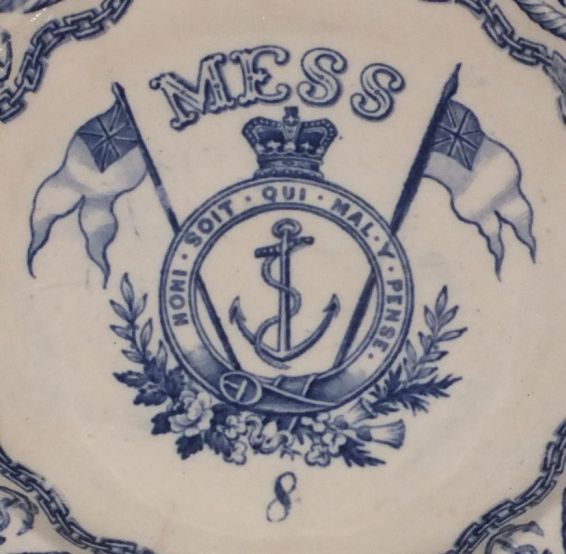
Pattern #13 - Pre-1907 Pattern Consisting of a Simple Center Buckle or Badge but VERY Detailed Illustrations of Royal Navy Officers Presumably on Liberty Visiting Foriegn Conquered Lands
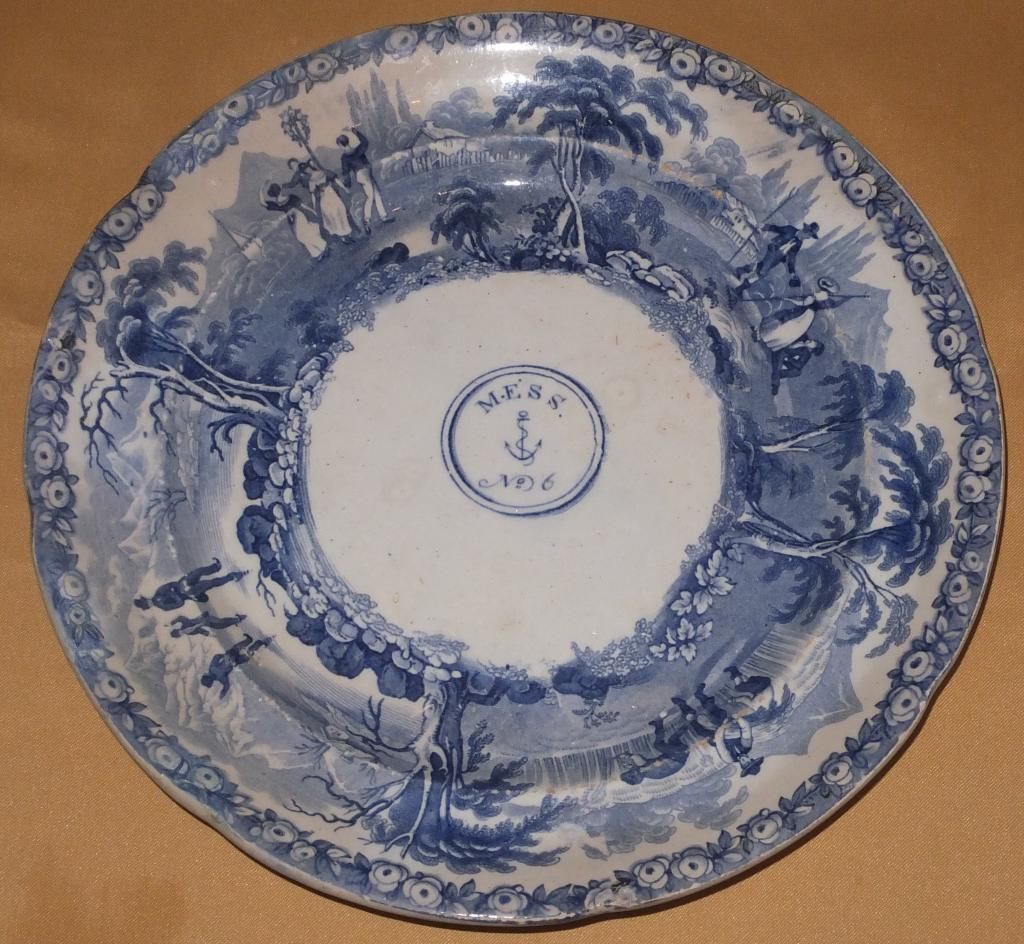
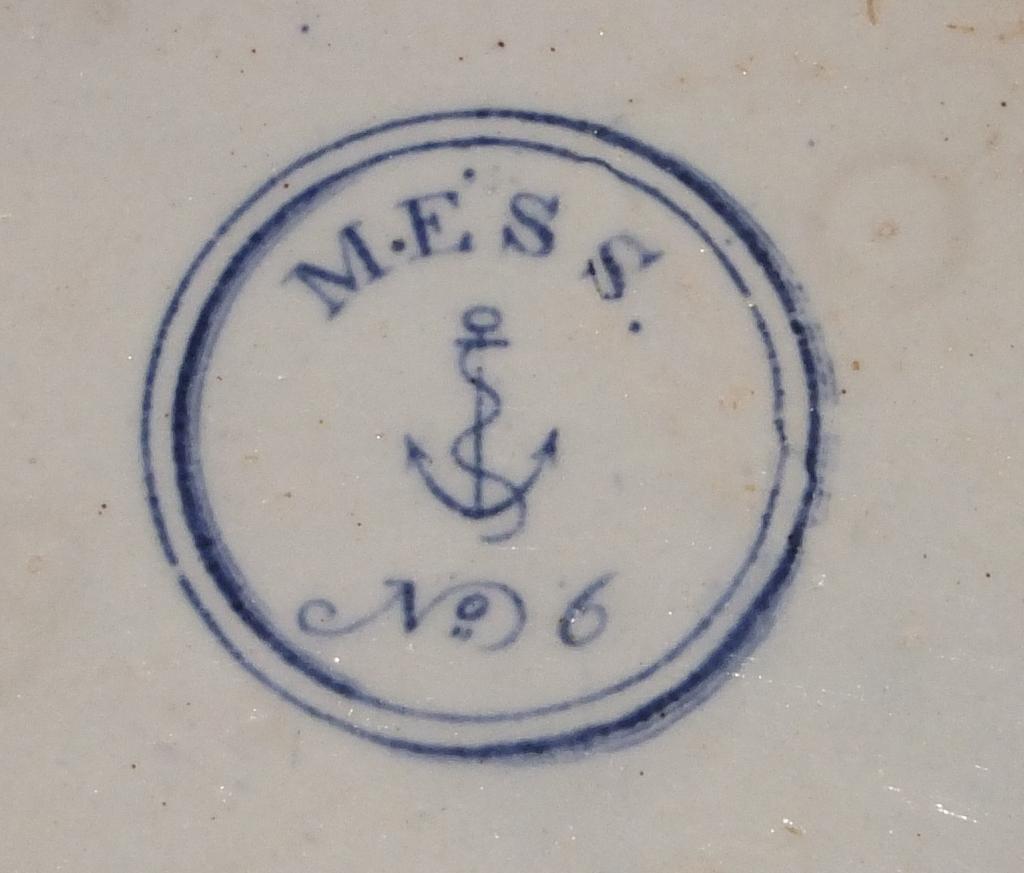
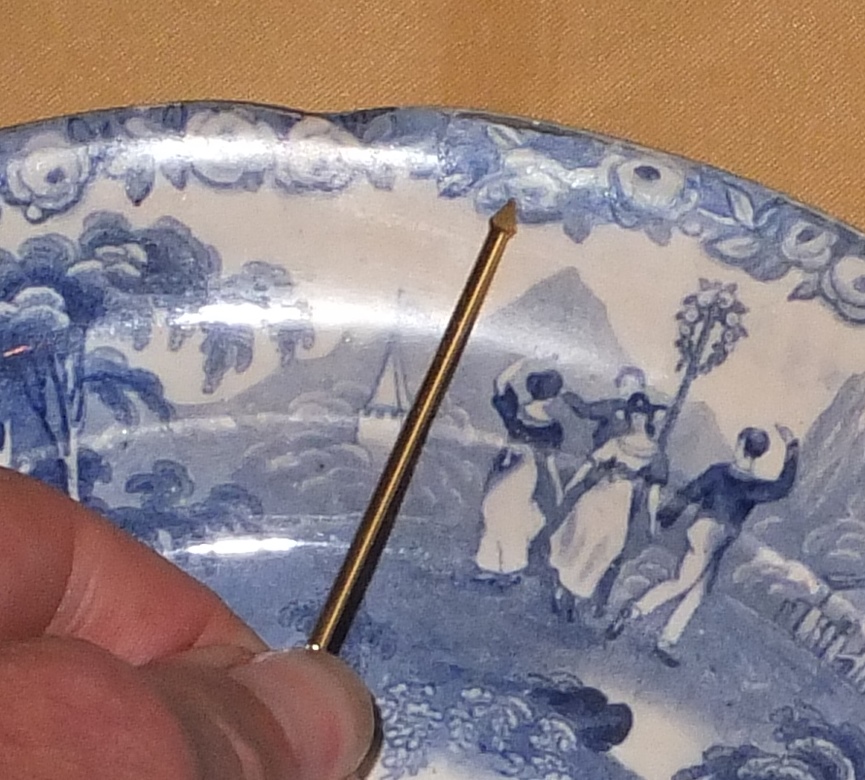
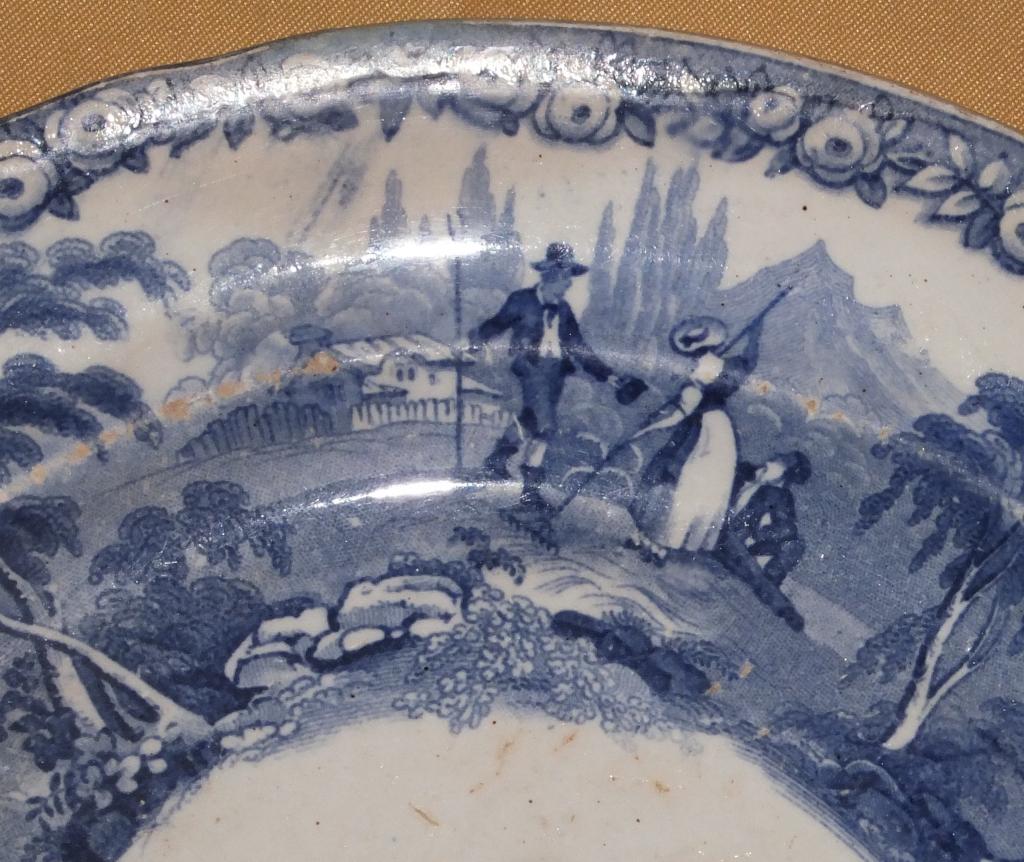
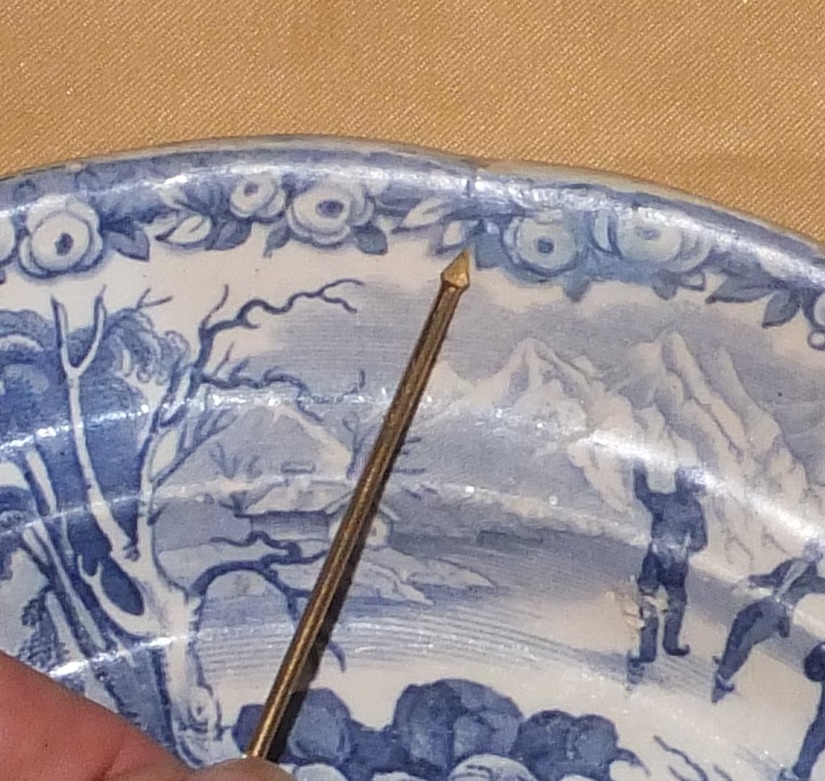
The illustrations on this very rare plate are very detailed
Pattern #14 - Covered Serving Bowl for British Royal Marines - Post-1907 Pattern Consisting of a Fouled Anchor under Crown Surrounded by Floral
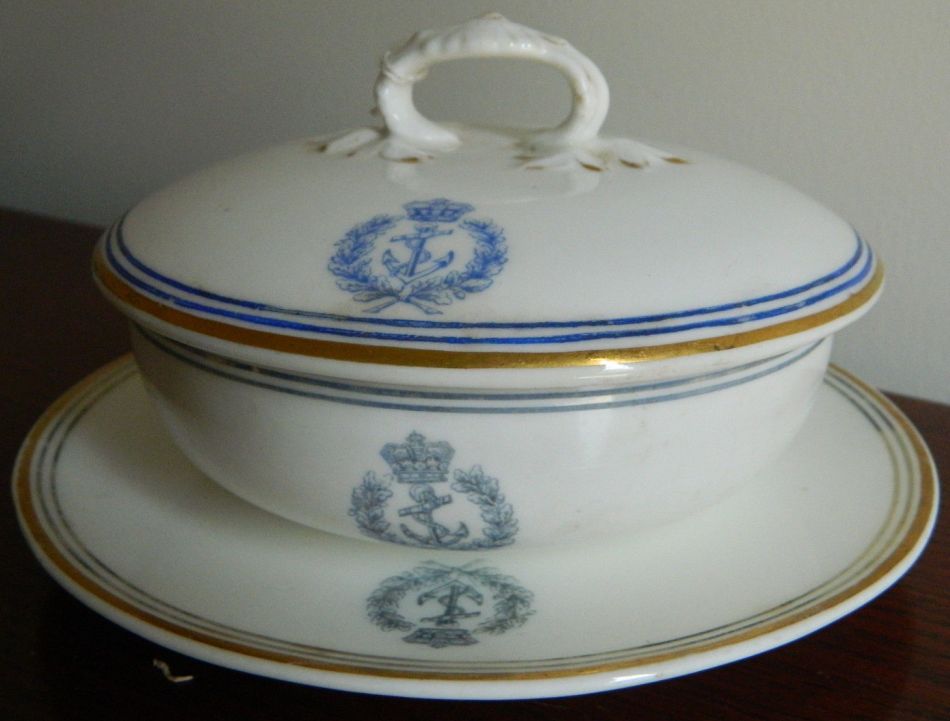
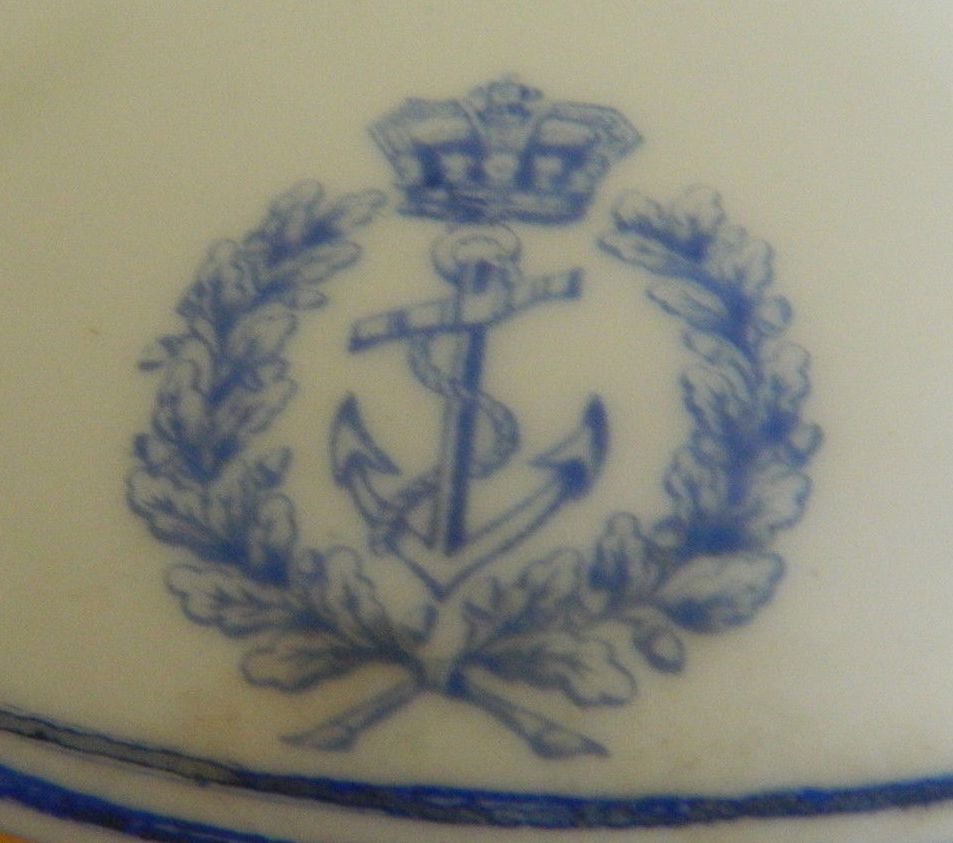
Pattern #15 - Post-1907 Pattern of a Bowl for the British Royal Marines
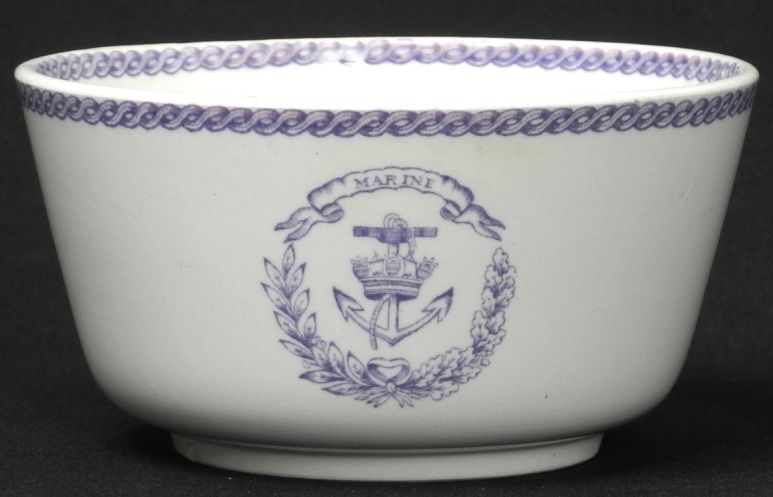
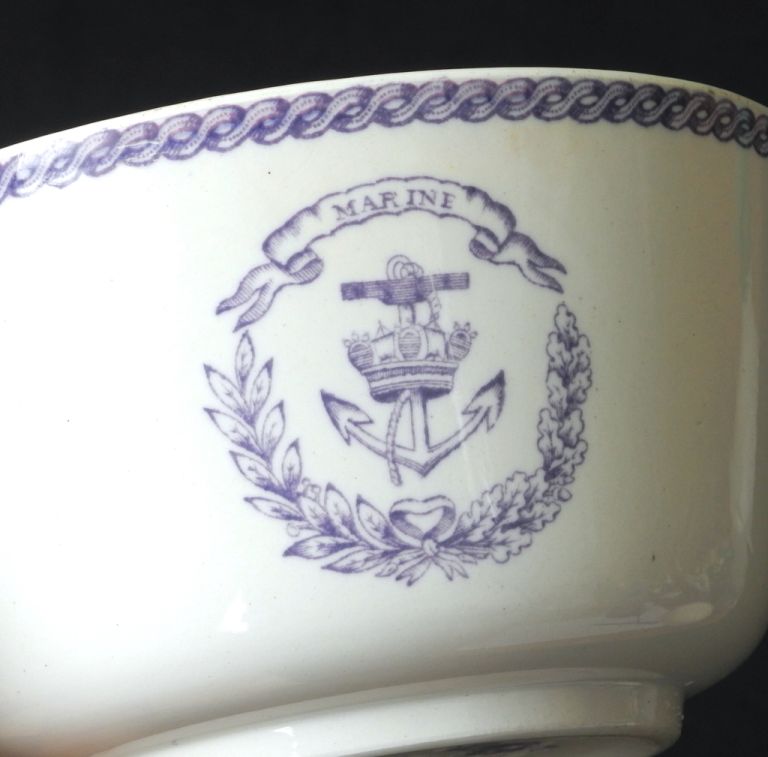
Simple Bowl with a Naval Badge and designated for the British Royal Marines.
Pattern #16 - Pre-1907 1840s-1880s Mess Plate w/ "Mess 12" as part of the Badge and Crown w/ Banner "H.M. Royal Navy"
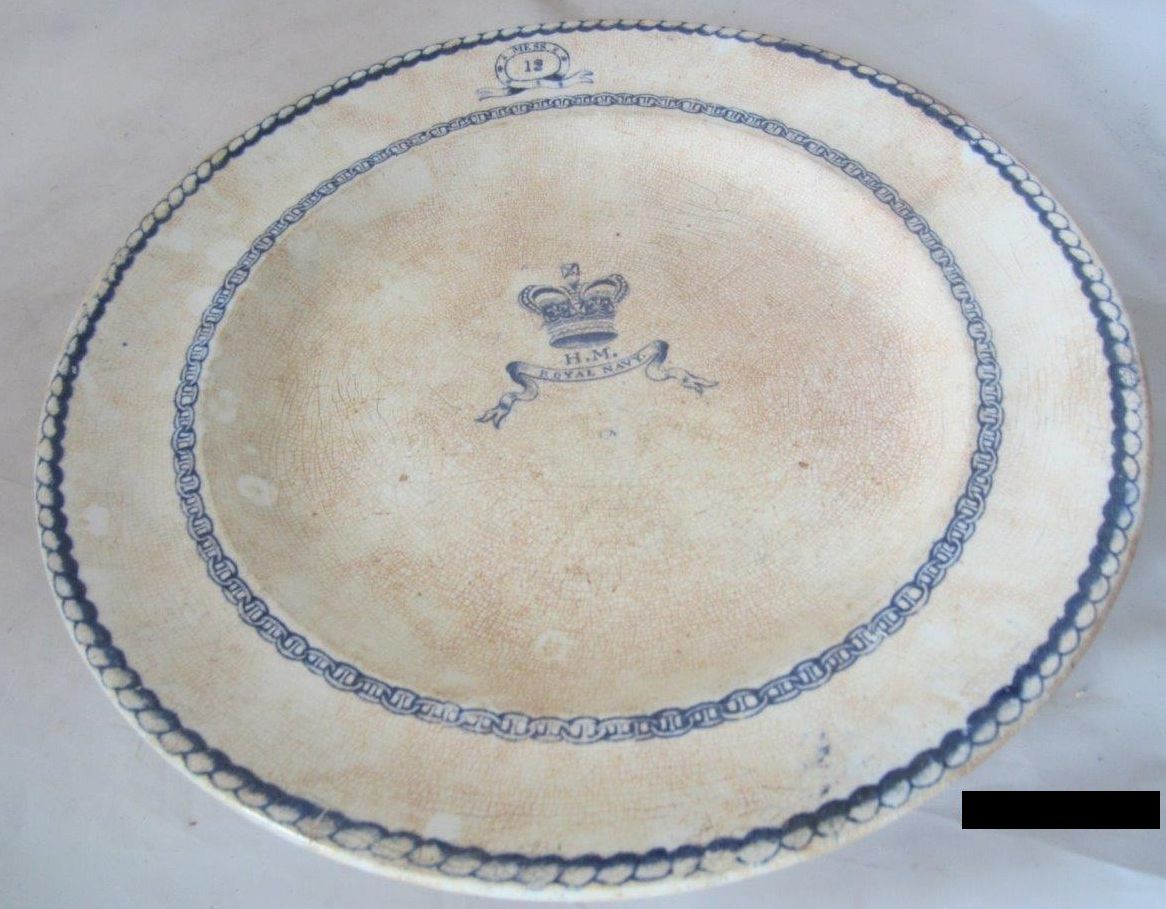
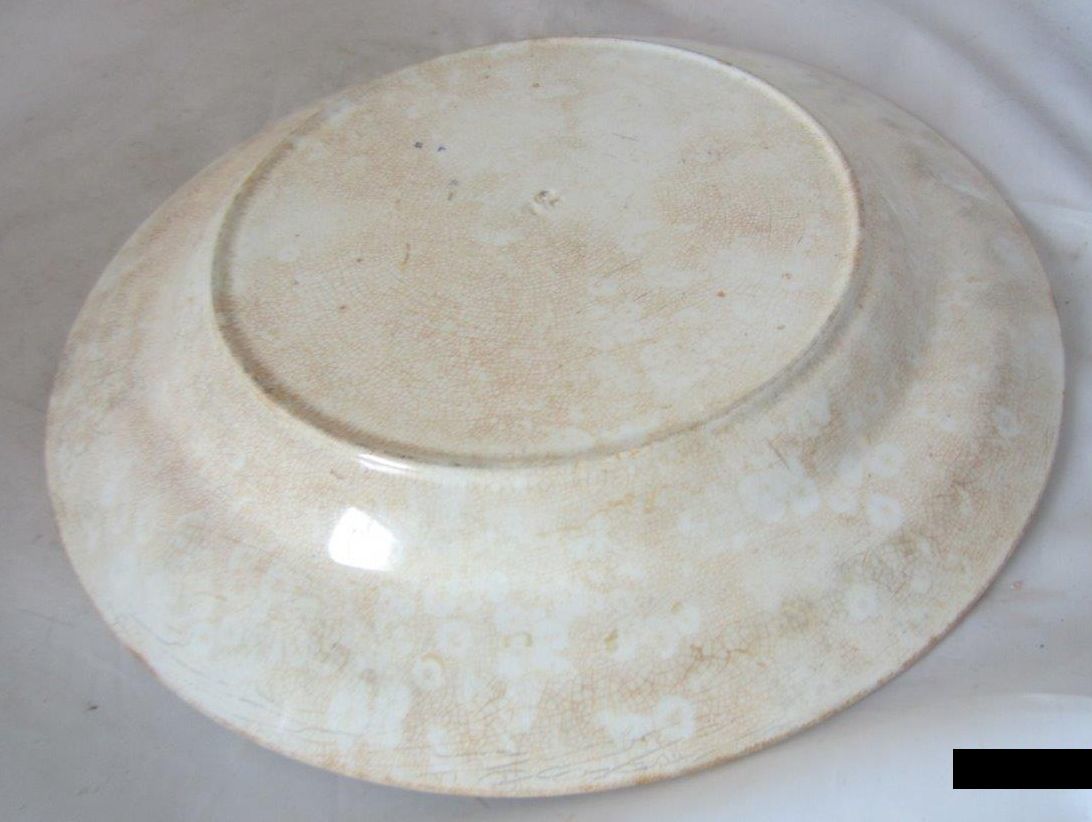
Mid 1800s Queen Victoria Era Royal Navy Mess Plate with an outer ring of rope along the edge of the rim and an inner circle of chain. There is a Naval Badge or Garter between the rope and the chain and reads "Mess 12". The centerpiece is the Royal Crown and a Banner reading "H.M Royal Navy". This plate has a lot of crazing and staining, and may have been an underwater find in the port of Portsmouth.
Pattern #17 - Pre-1907 1850s-1880s Mess Plate w/ "Mess 6" as part of the Center Buckle w/ Badge of the Royal Navy and "HMS Conqueror"
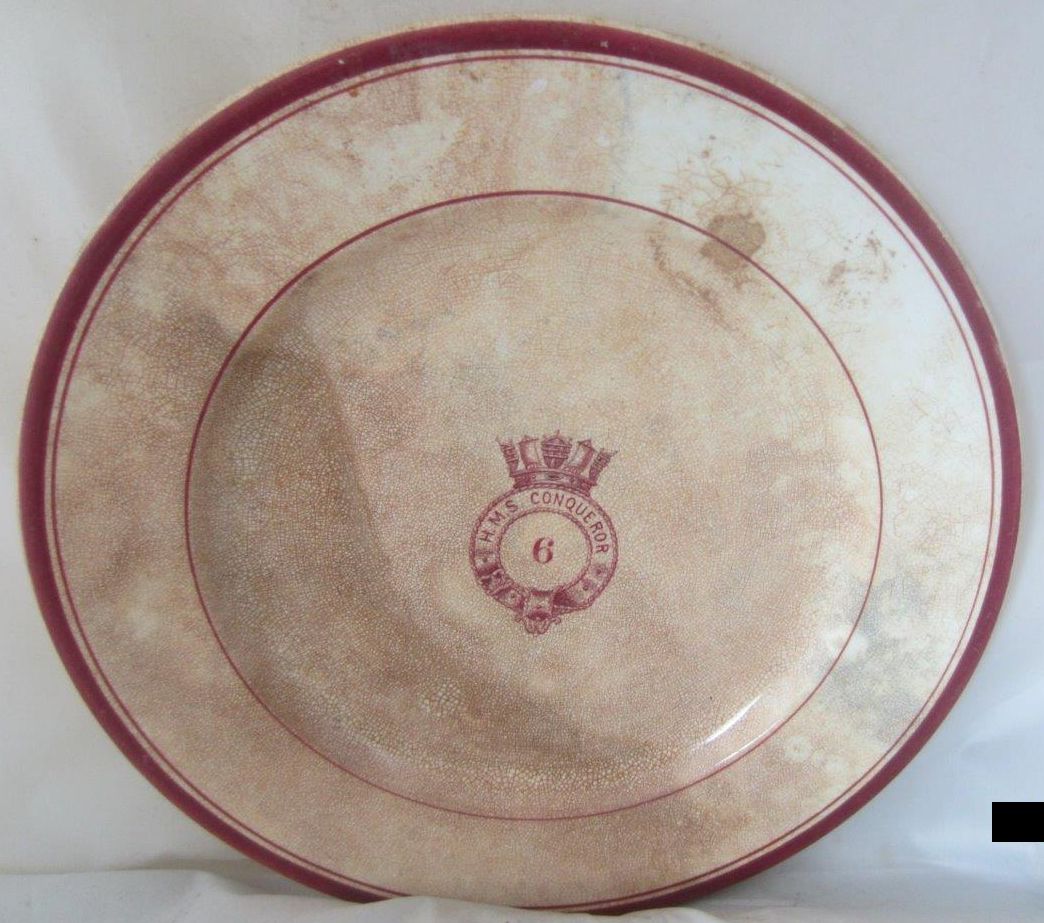
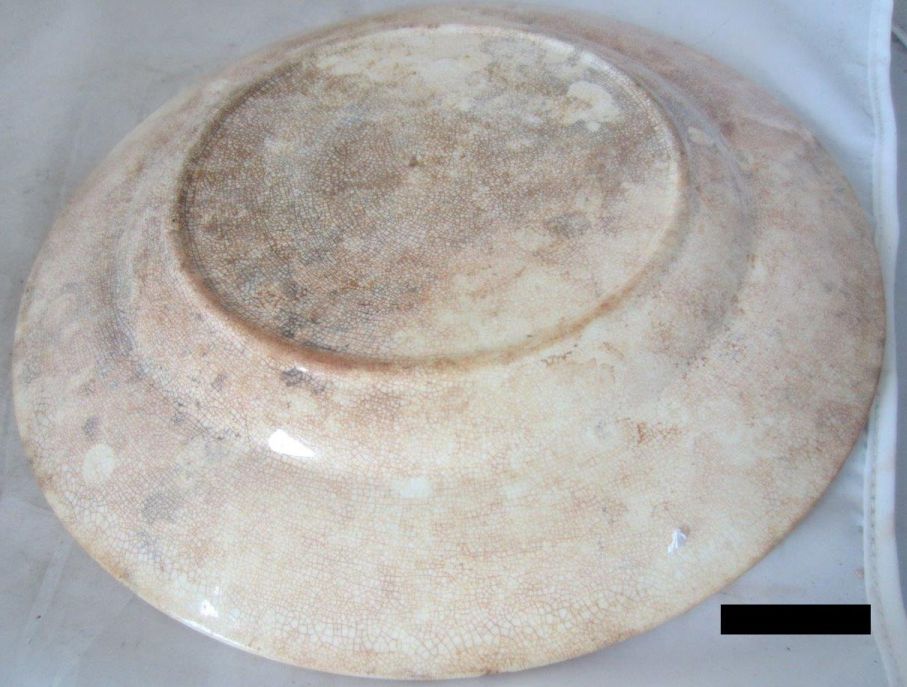
Mid 1800s Queen Victoria Era Royal Navy Mess Plate made for the HMS Conqueror with plain burgundy outer rings w/ "Mess 6" as part of the Center Buckle w/ Badge of the Royal Navy and "HMS Conqueror". This plate has a lot of crazing and staining and may have been an underwater find in the port of Portsmouth.
Pattern #18 - Pre-1907 1850s-1880s Mess Bowl w/ "Mess 21" as part of the Center Buckle w/ Badge of the Royal Navy and "HMS Cambridge"
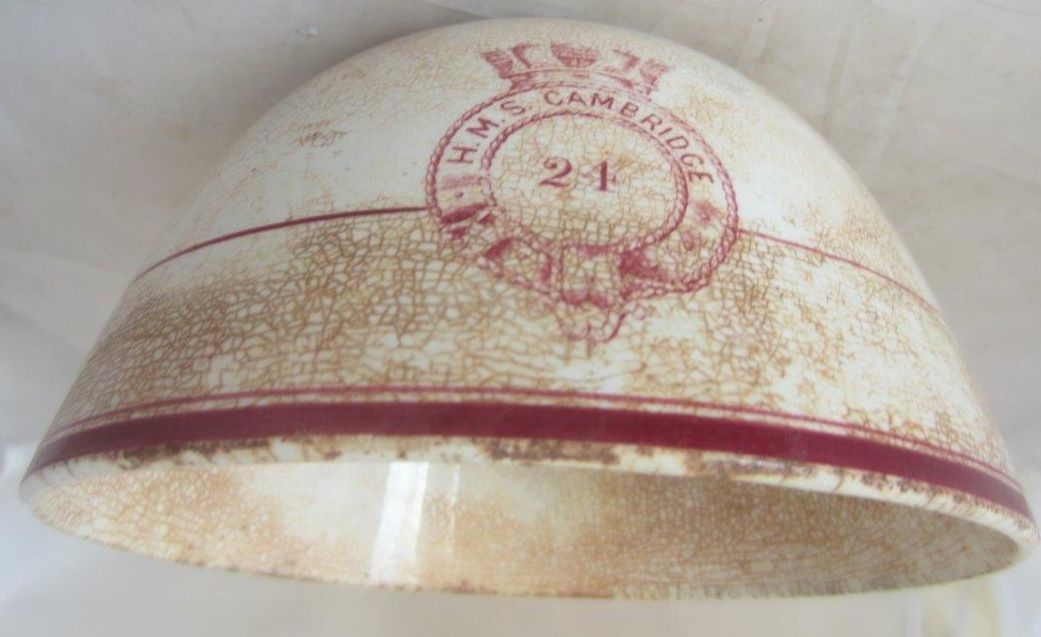
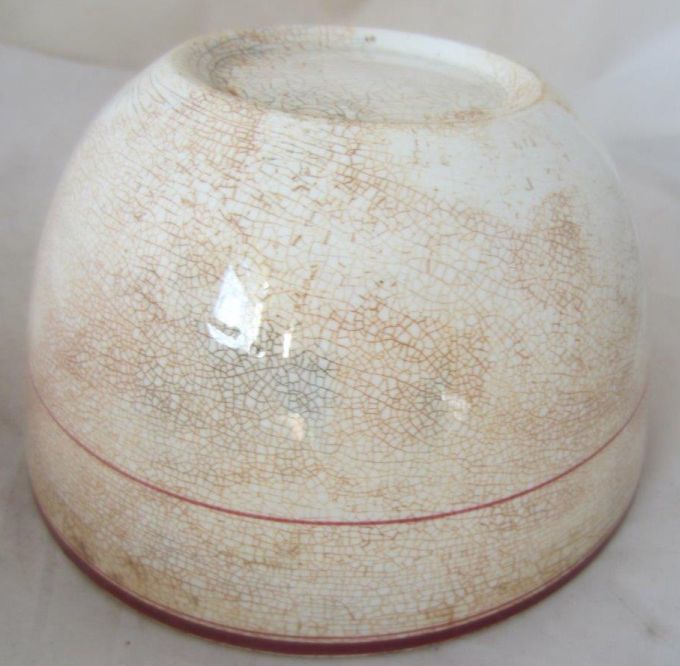
Mid 1800s Queen Victoria Era Royal Navy Mess Bowl made for the HMS Cambridge with plain burgundy outer rings w/ "Mess 21" as part of the Center Buckle w/ Badge of the Royal Navy and "HMS Cambridge". This bowl has a lot of crazing and staining and may have been an underwater find in the port of Portsmouth.
Pattern #19 - Pre-1907 Mid 1800s Mess Plate w/ a Royal Crown above a Fouled Anchor and Surrounded by a Wreath and signed "TS" for Transporation Services which provided the worldwide transporation needs of the Royal Navy and othe branches of the British Government and Military. Think of this as the equivalent to the American Merchant Marine.
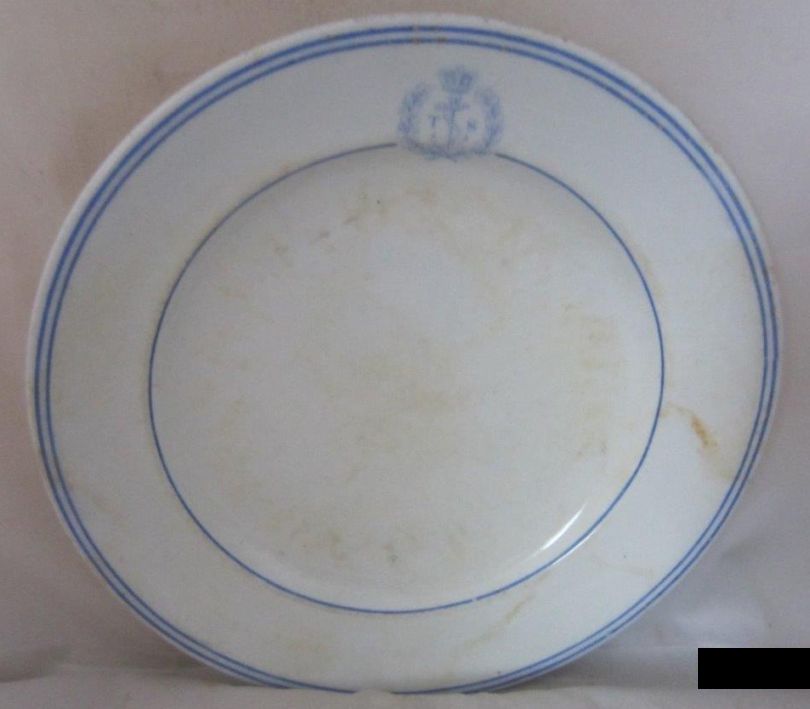
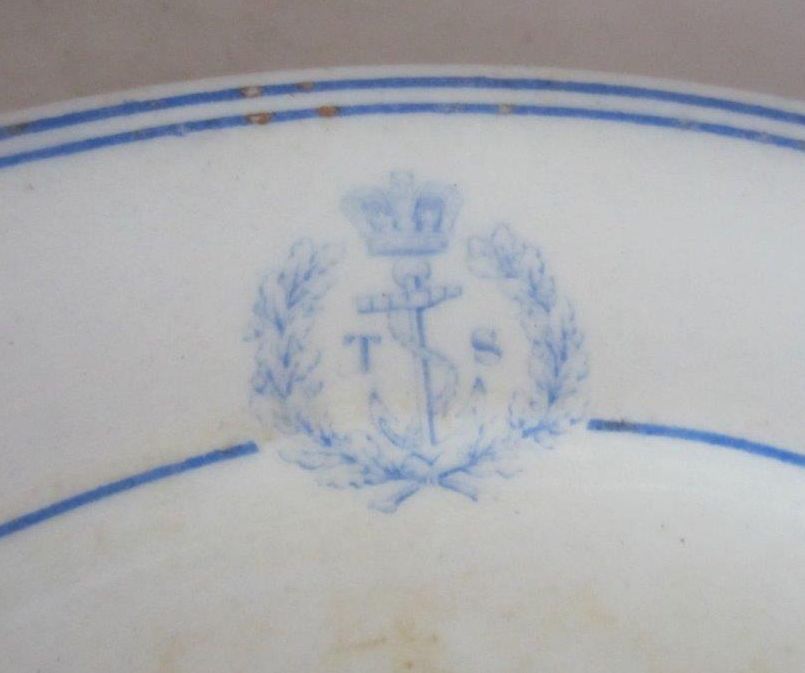
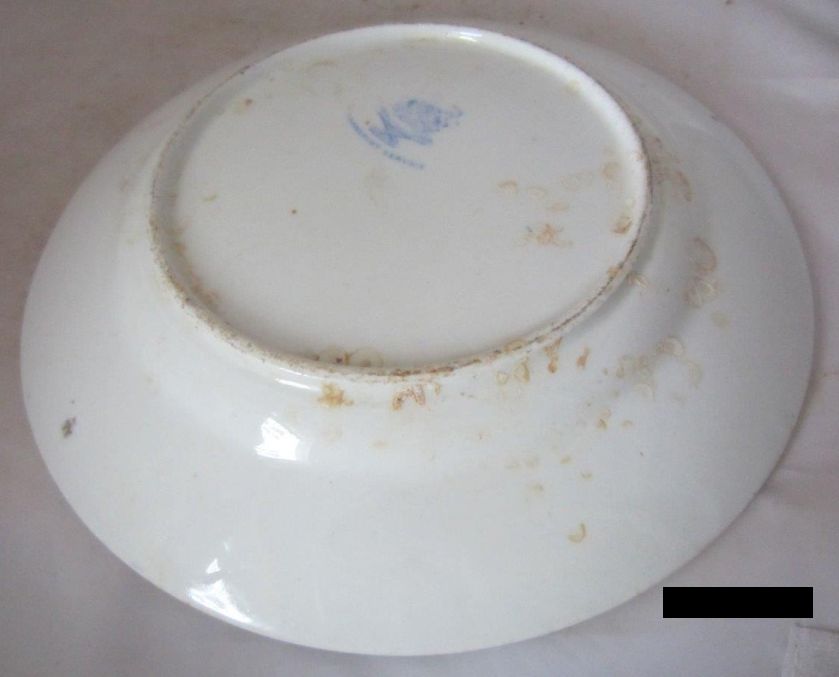
Mid 1800s Queen Victoria Era Royal Navy Mess Plate made for the "Transportation Services" of the British Government consisting of a Royal Crown above a Fouled Anchor and Surrounded by a Wreath and signed "TS" for Transporation Services. This plate has a lot of crazing and staining and may have been an underwater find in the port of Portsmouth.
Pattern #20 - Pre-1907 Mid 1800s Mess Plate w/ a Simple Non-Naval Geometric Design and a Plain Numeral Mess Designation "20". There Have Been Other Similar Mess Plates Used by the Royal Navy Where the Only Design Was a Geometric One. Most Likely the Lower Cost for a Simple Plate Such as this was the Driving Factor in Procuring it for a Smaller Naval Vessel.
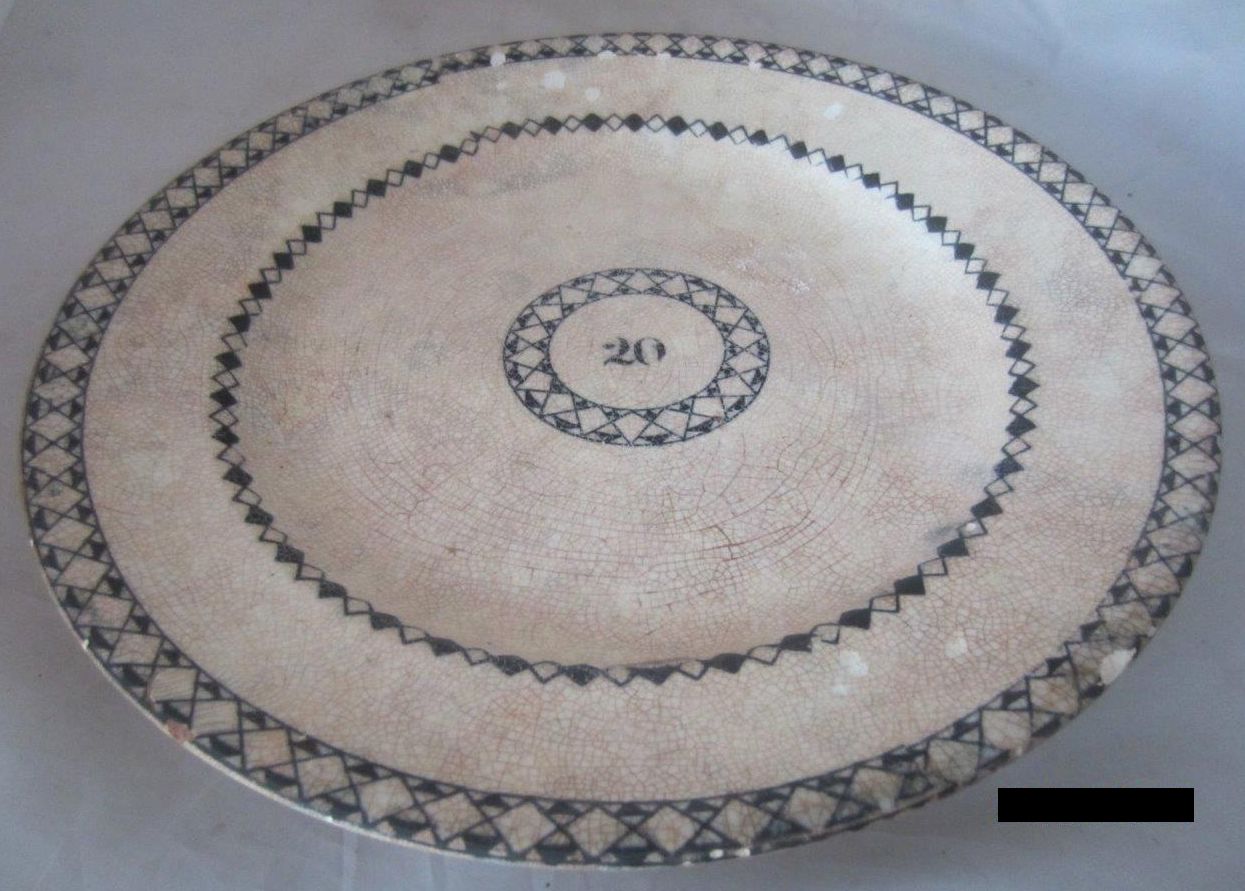
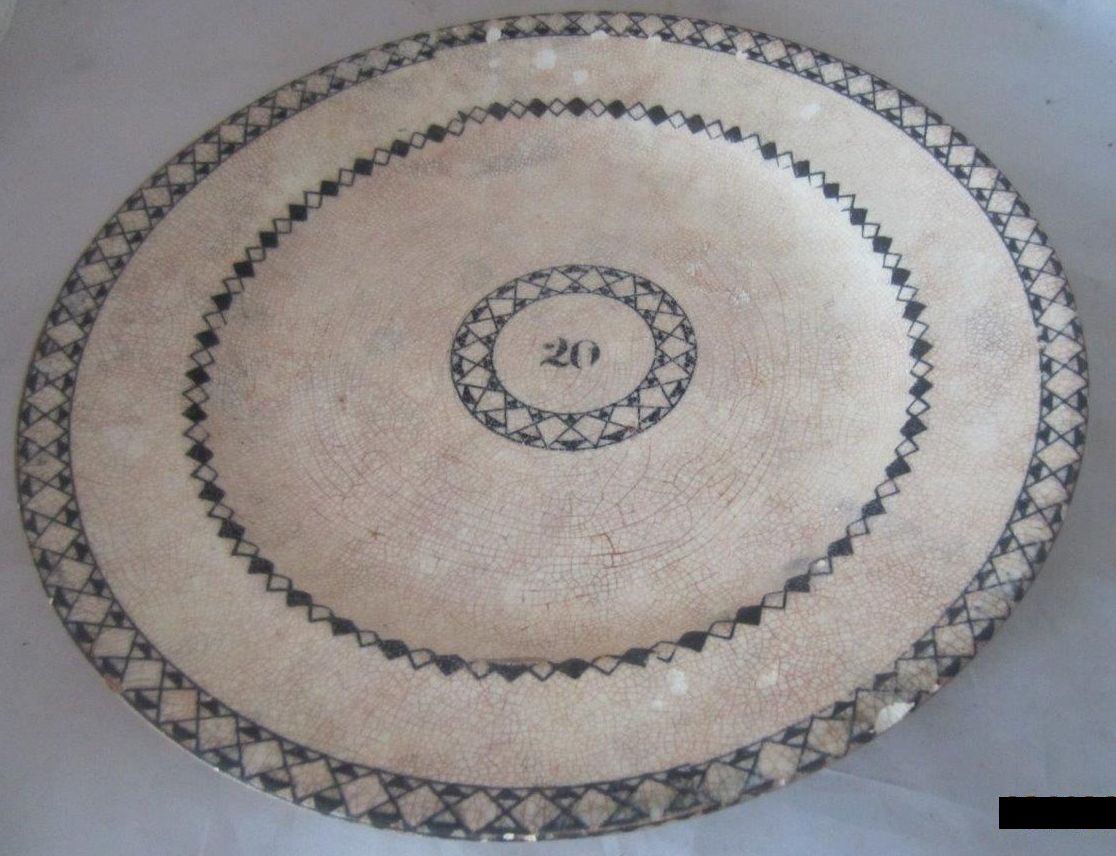
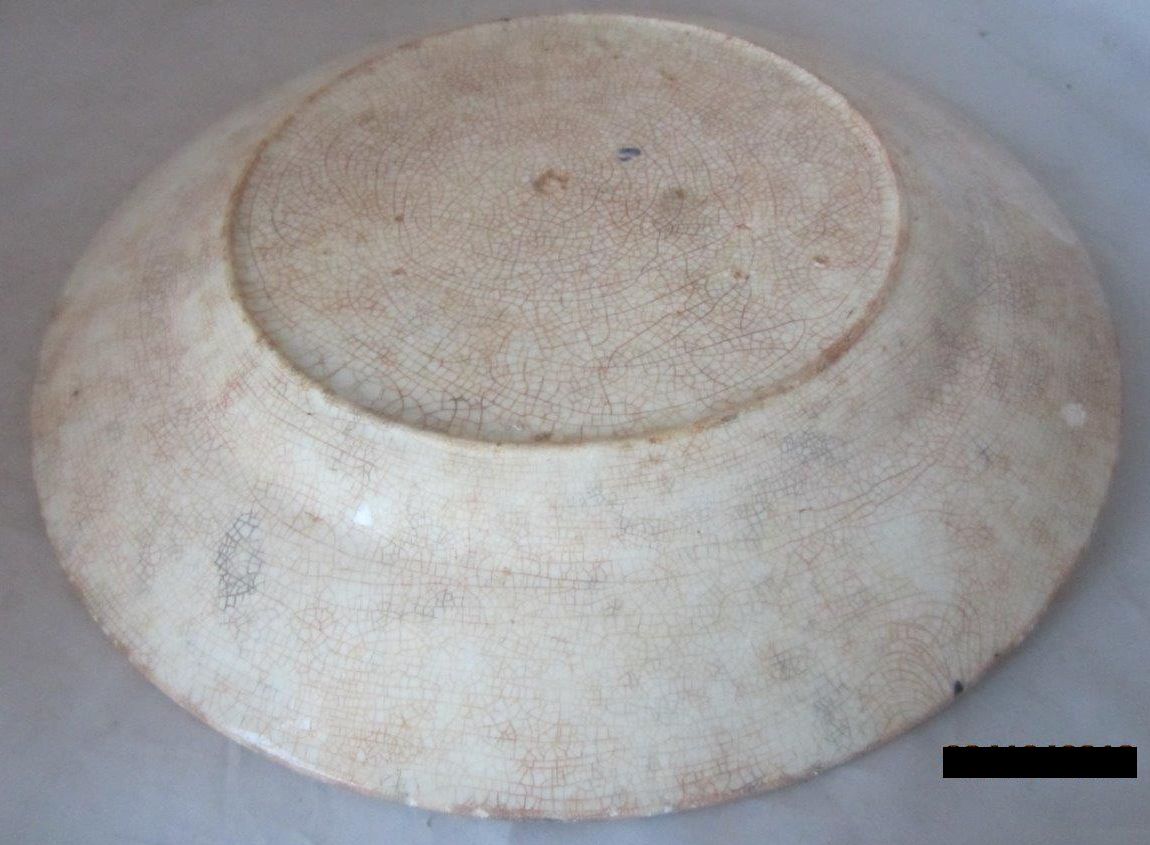
Pattern #21 - Pre-1907, 1830s-1850s British Royal Navy Mess Plate w/ a Detailed Design Made Specifically for the Royal Navy and Consisting of an Outer Rim of Twisted Rope Follwed by a Border of Thistles (Scotland), Roses (England), and Shamrocks (Ireland) followed by a Geometric Design and Another Ring of Twisted Rope. In the Center is Her Majesty's Crown Above "No 25 MESS" and Below That the British Navy's Fouled Anchor. Quite a Beautiful Plate!
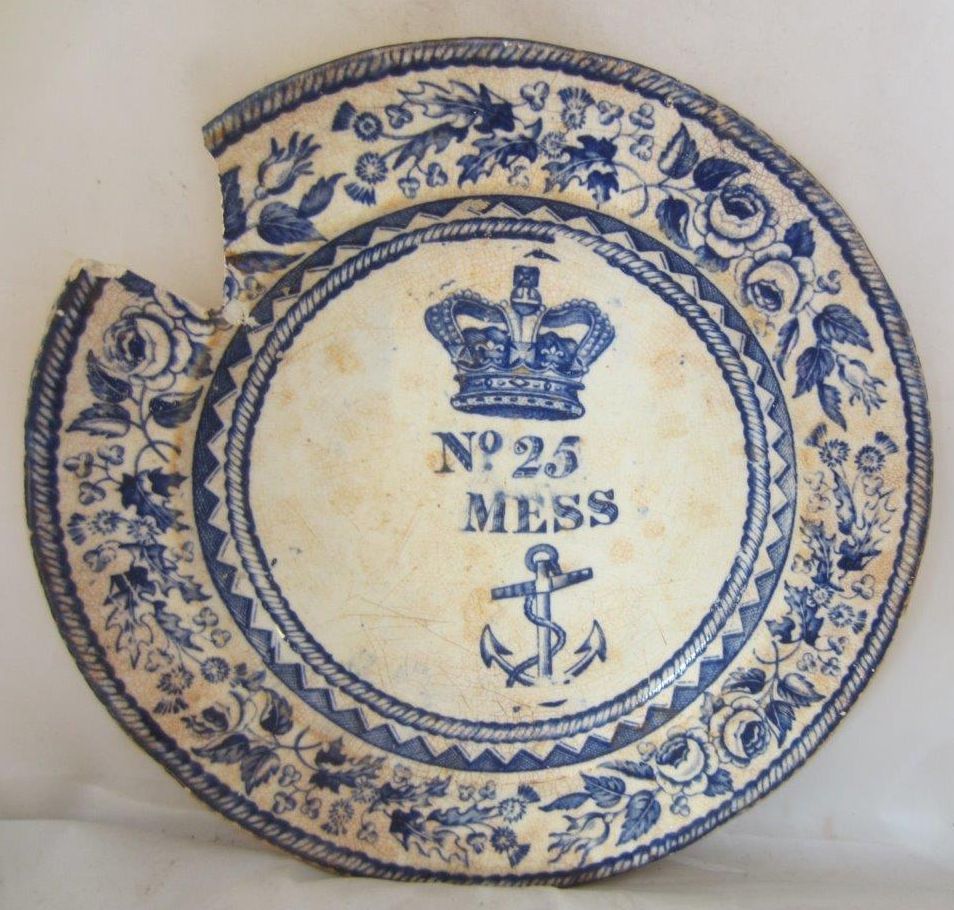
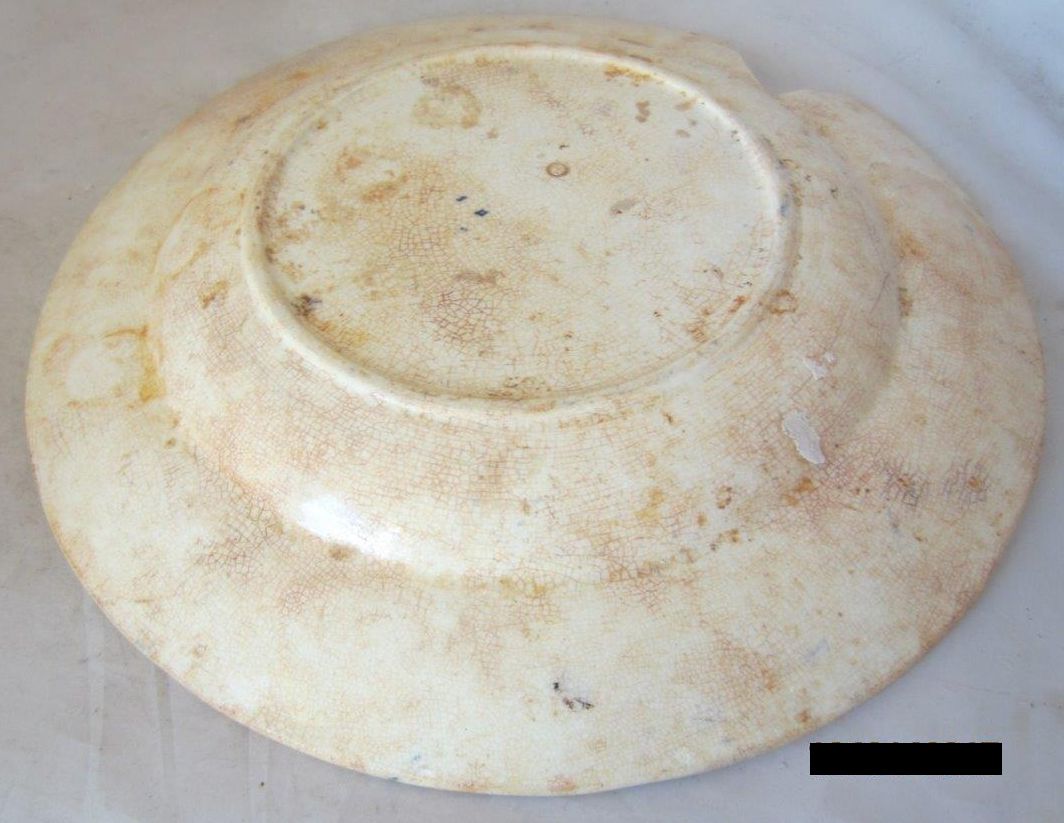
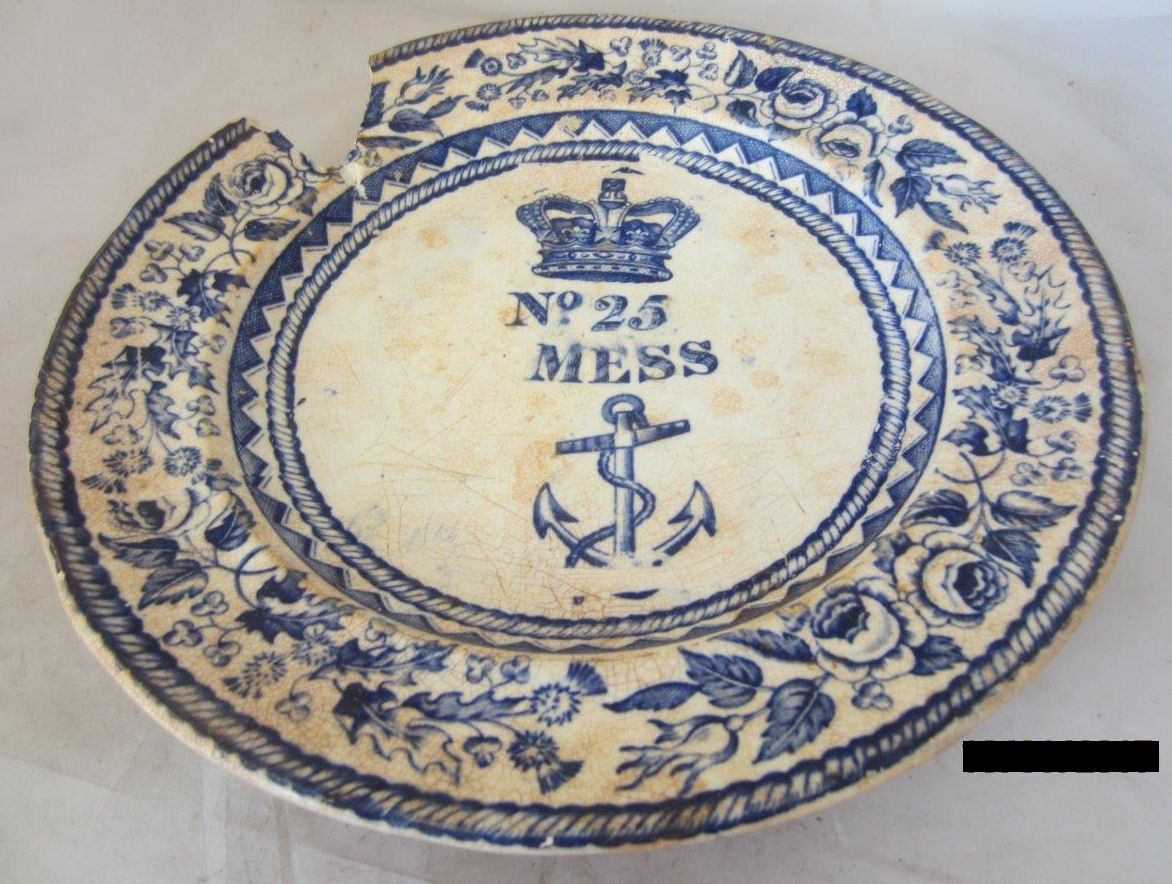
Royal Navy China Manufacturer Backstamps and Arsenal Marks
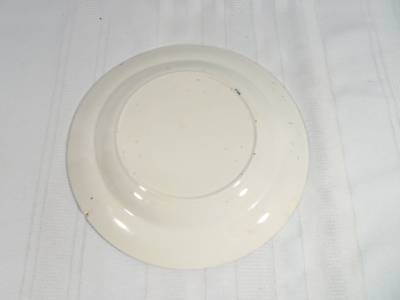
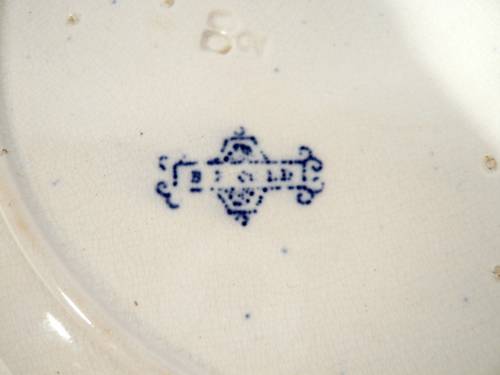
Mess Plate to the left does not show any backstamp which is not atypical for this period, while the photo to the right shows the Bovey Tracey Pottery Company to the right which made much of this 1850-1890 Royal Navy dinnerware. Bovey Tracey was a major china manufacture for the Royal Navy dinnerware in the 19th century and in fact produced plates and bowls sold under the name of retailers who re-sold the plates to the Royal Navy.
Below are links to other Antique Nautical and Naval Artifacts that may be of interest:
Click HERE for WWII US Navy Anchor China
Authentic 100+ Year Old Nautical Antique Trunks
The Real Deal! Fully Restored Antique Trunks Like Sea Chests, Pirate Chests, Treasure Chests - Perfect as a Naval Retirement Gift, use as a Shadowbox and to store Uniforms and Service Memorabilia! |
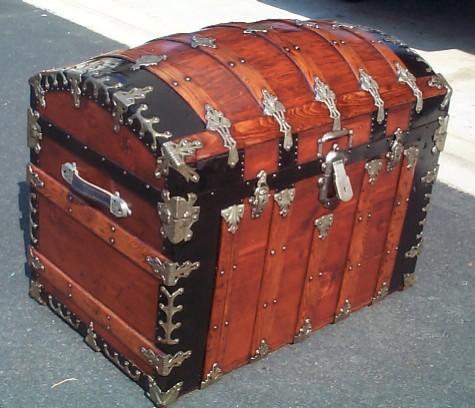
Click Here To Review Sample Engravings |
The Largest Selection of Antique Trunks on the Net to Choose From! |
OPTIONAL - Trunk Wood Engraving Examples and Prices
Custom Designed, Handcrafted, and Hand Lettered in Caligraphy on your Antique Chest |
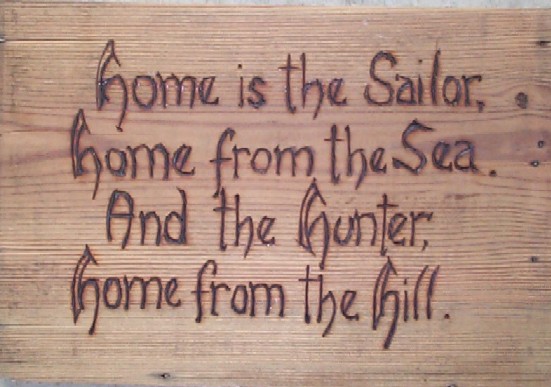
Click Here To Review Sample Engravings |
Personalize Your 100+ Year Old Antique Trunk in Perpetuity! |
Antique Trunks as a Shadow Box and Storage Chest!
Customer Photographic Examples of our Antique Trunks Being used as a Military or Naval Retirement Shadow Box and Storage Chest!! |
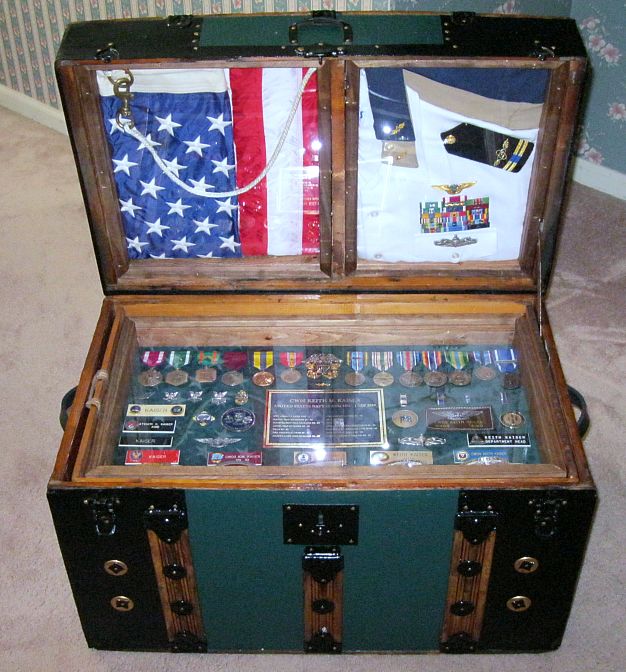
Click Here for Sample Shadow Box Photographs From Customers |
Why just get a shadow box or a newly made trunk with no history! One of our 100+ Year Old Nautical Antique Trunks can be used for both a Shadow Box and Storage Chest for your Uniforms, Photograph Albums, and Memorabilia! |
The Pirate's Lair
Division of DataCity, Inc.
78 Canterbury Drive
Stafford, Virginia 22554
Phone: 540-659-6209
Click Here and Return to The Pirate's Lair Home Page www.thepirateslair.com
"Service Disabled Veteran Owned Small Business"
Or
Email the-pirate@thepirateslair.com


 Or Click HERE to return to The Pirate's Lair Home Page and Gangplank!
Or Click HERE to return to The Pirate's Lair Home Page and Gangplank!
Copyright(c) 2008 All Rights Reserved - Unauthorized downloading, copying or use of any html code, text or images found on this or on any other pages within the www.pirateslair.com website will be prosecuted.
Music Credits: Donald Where's Your Trousers/Drunken Sailor medley by The Bards

























































































